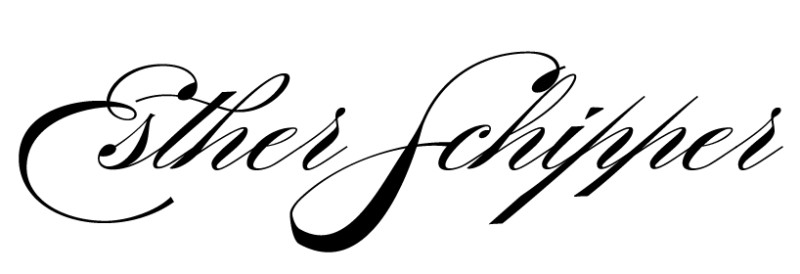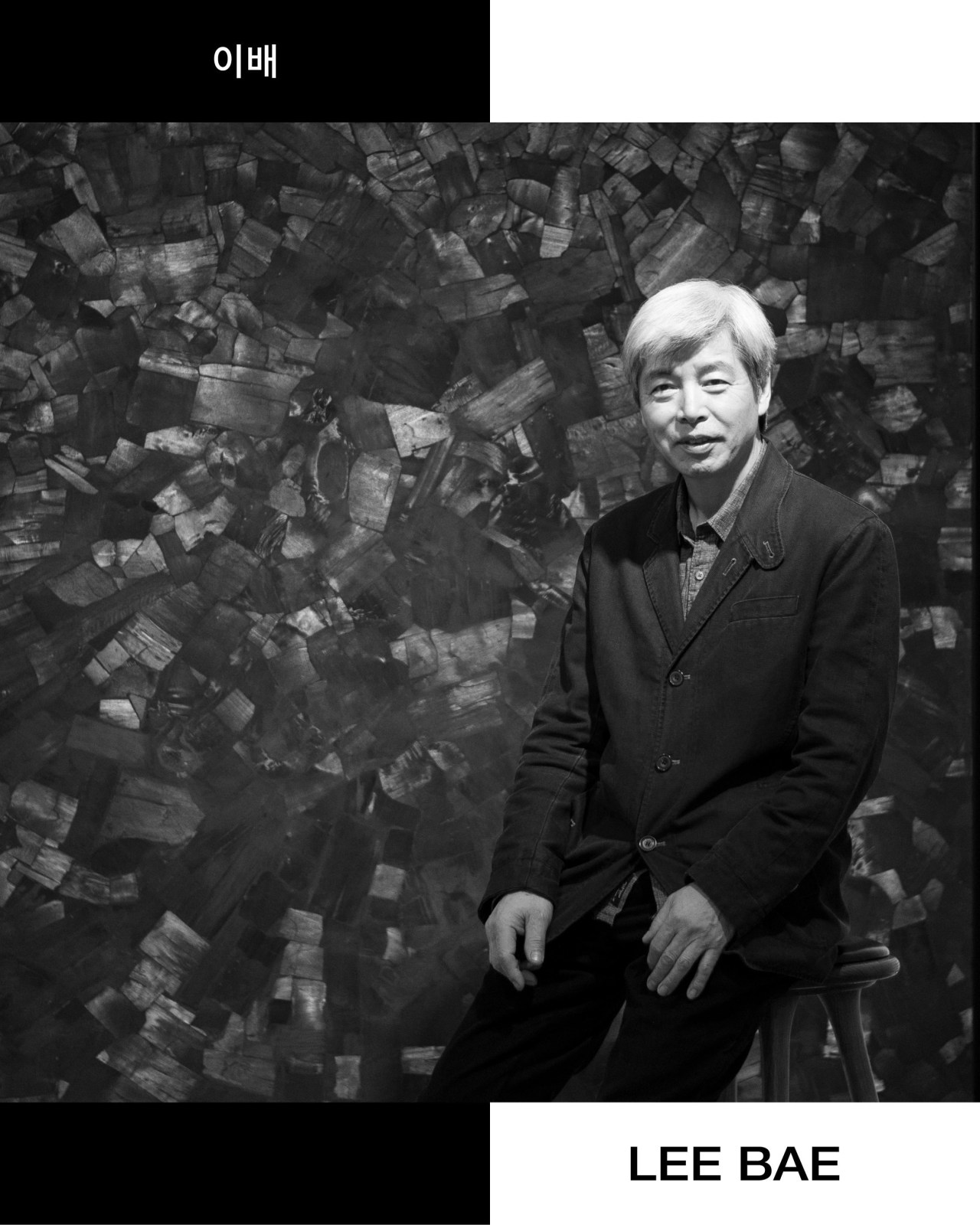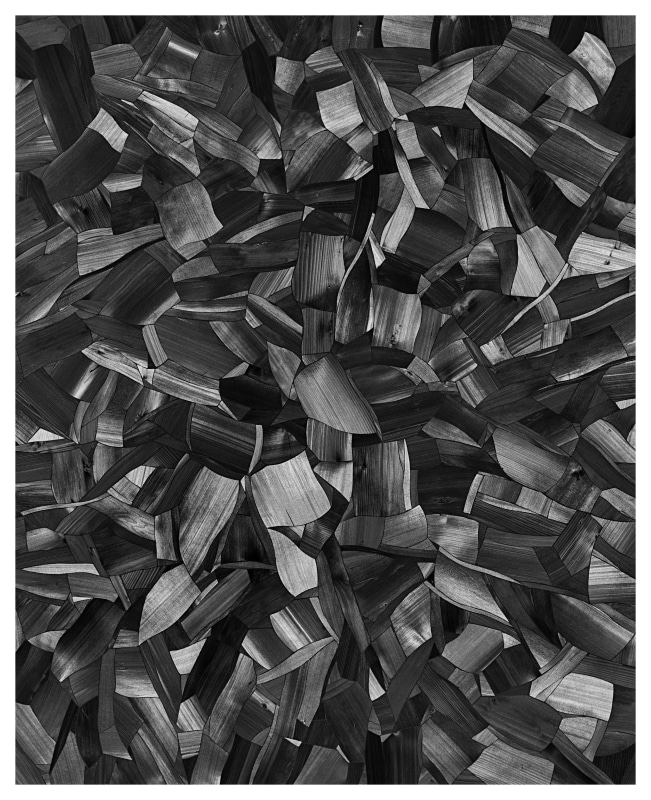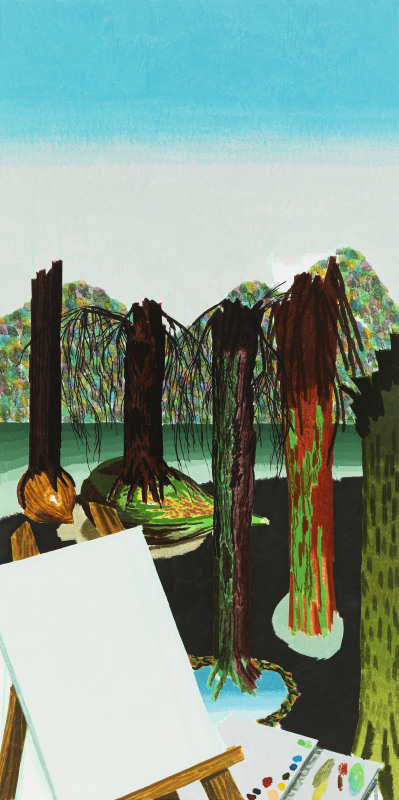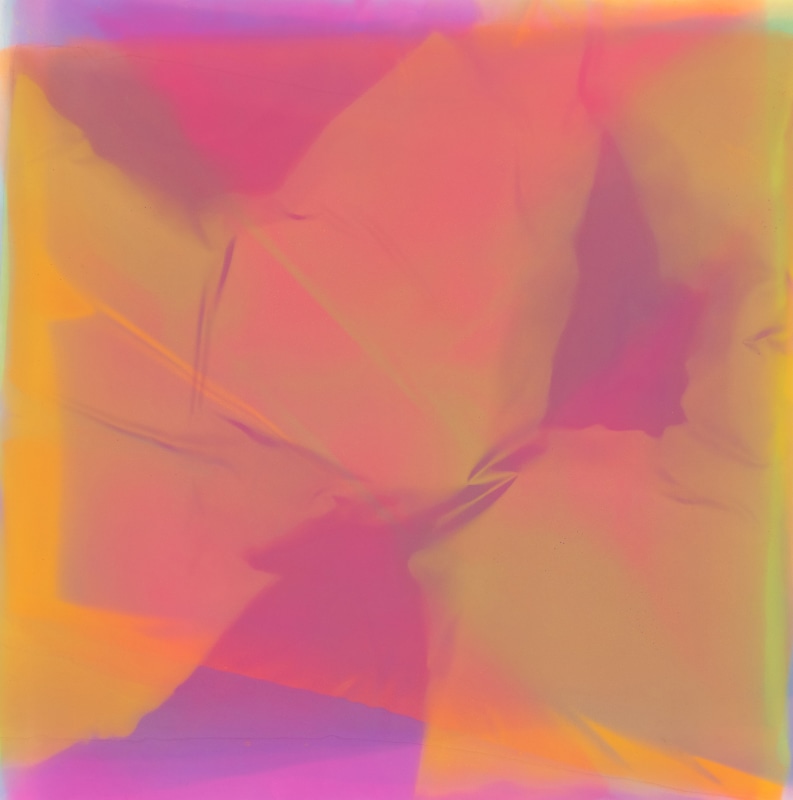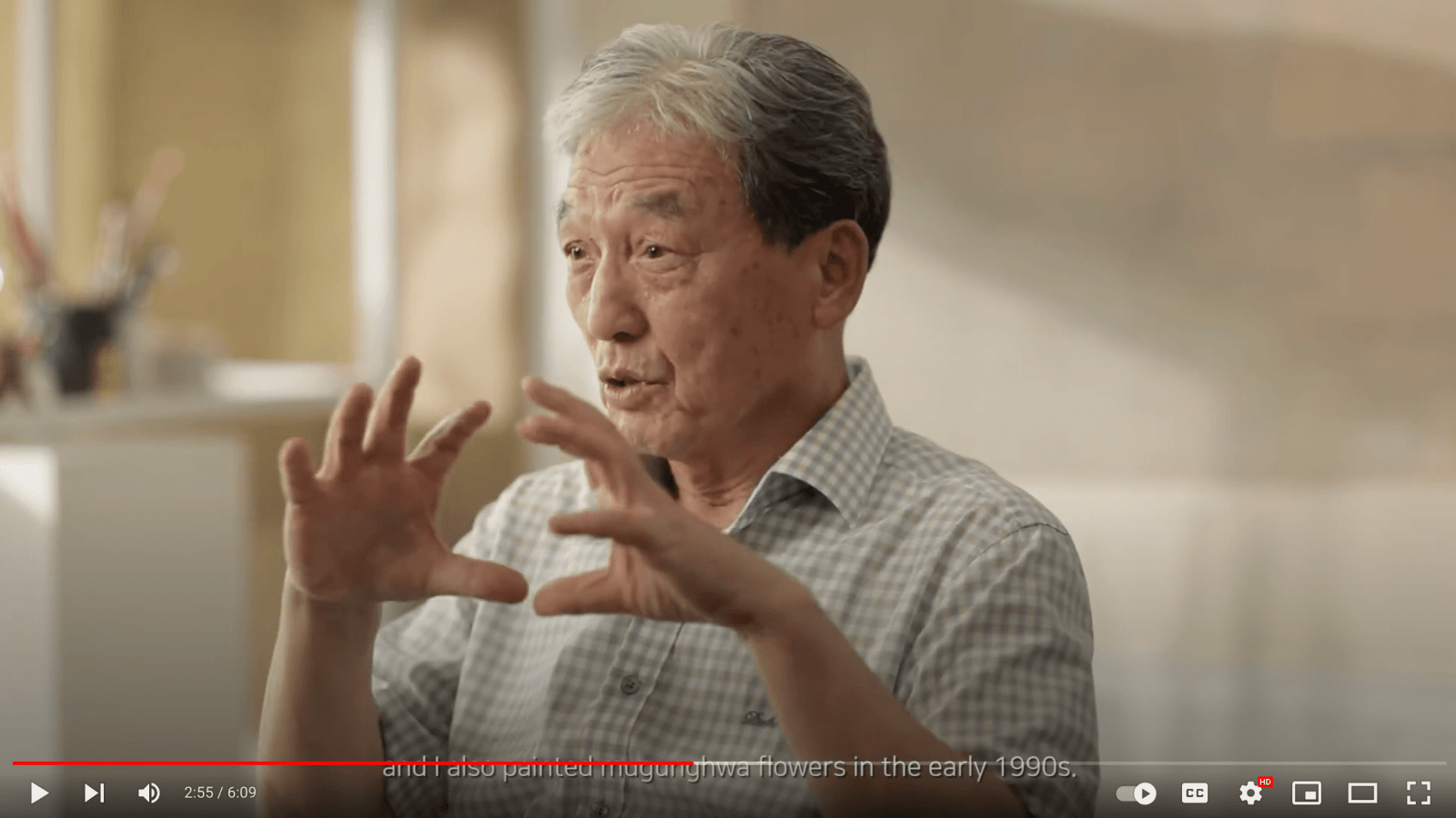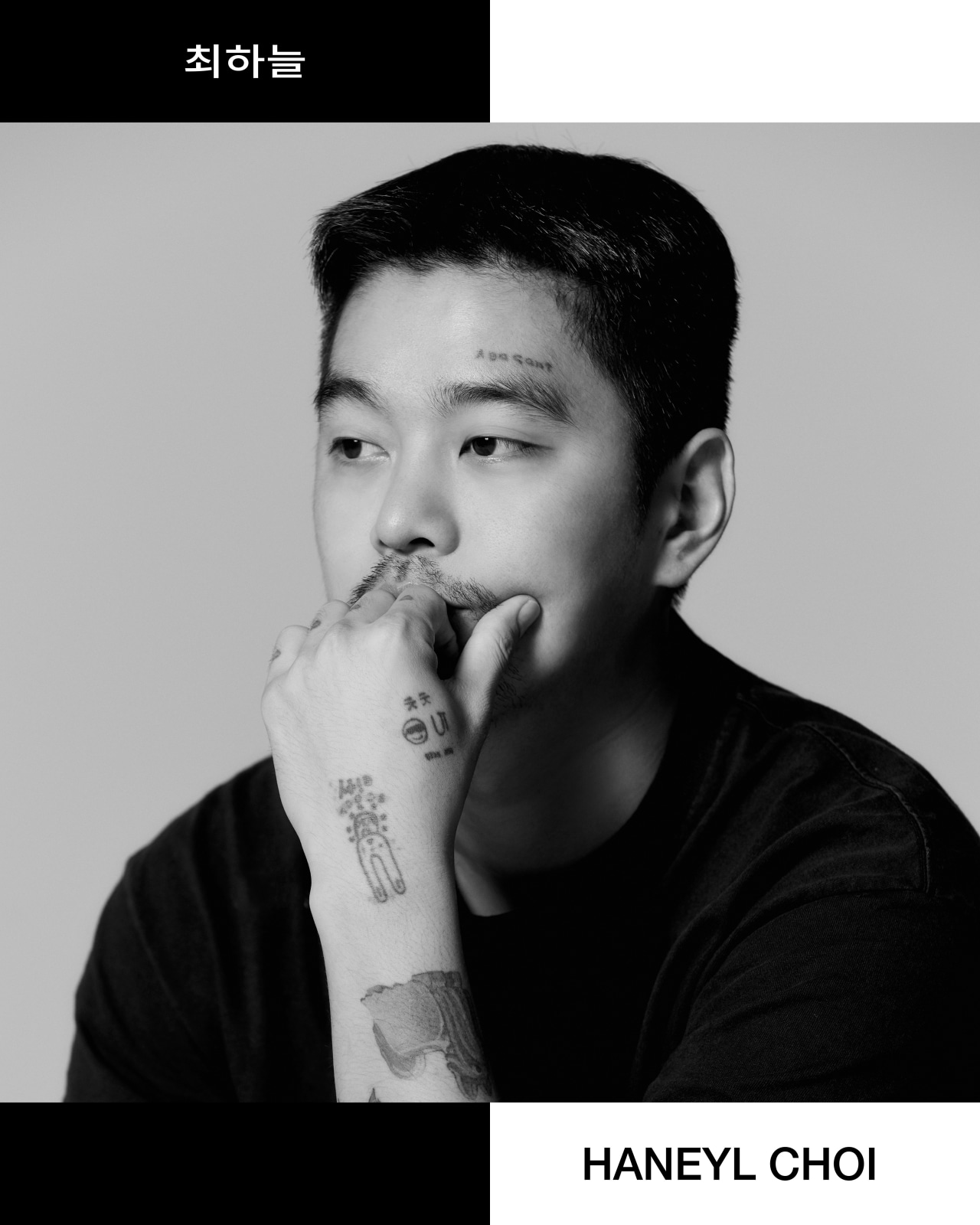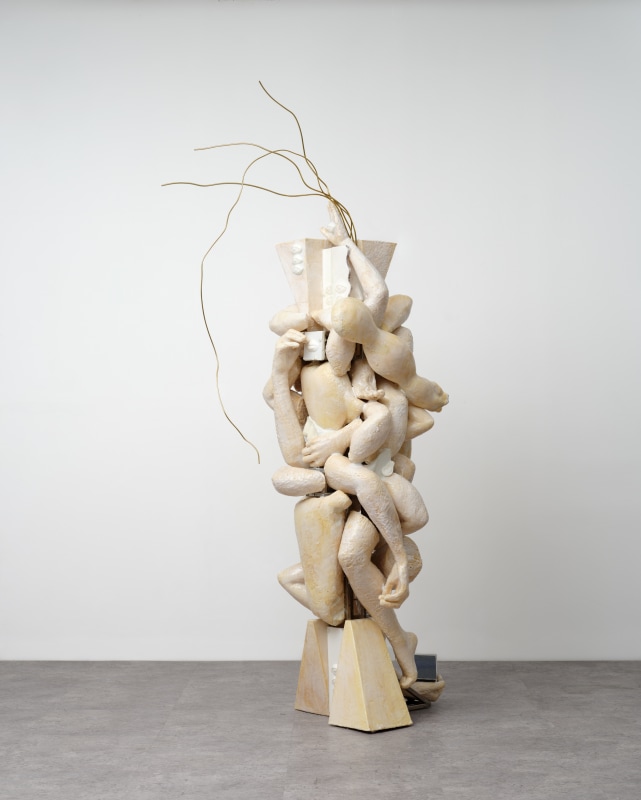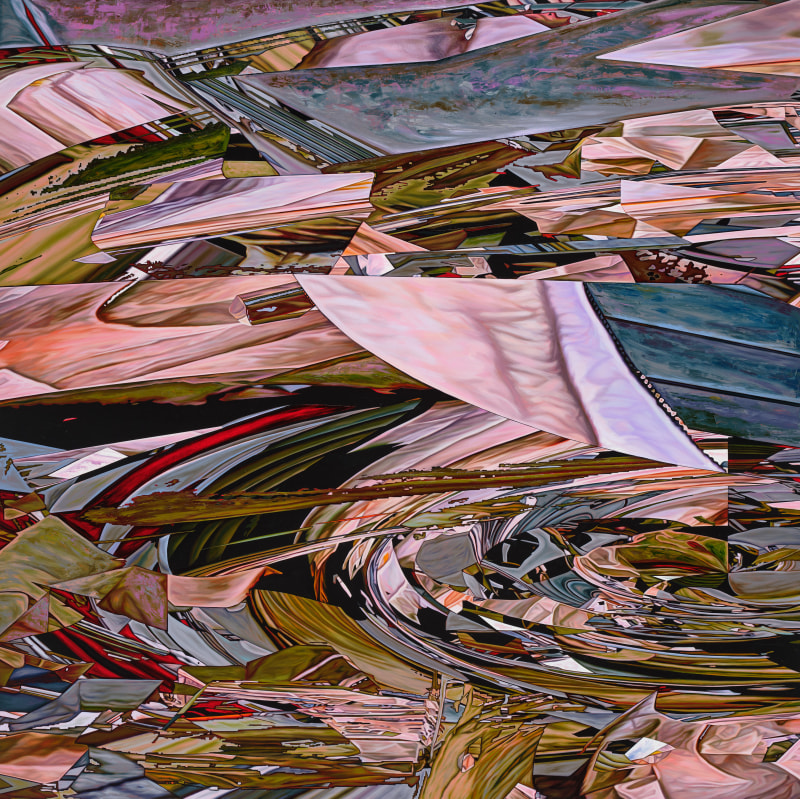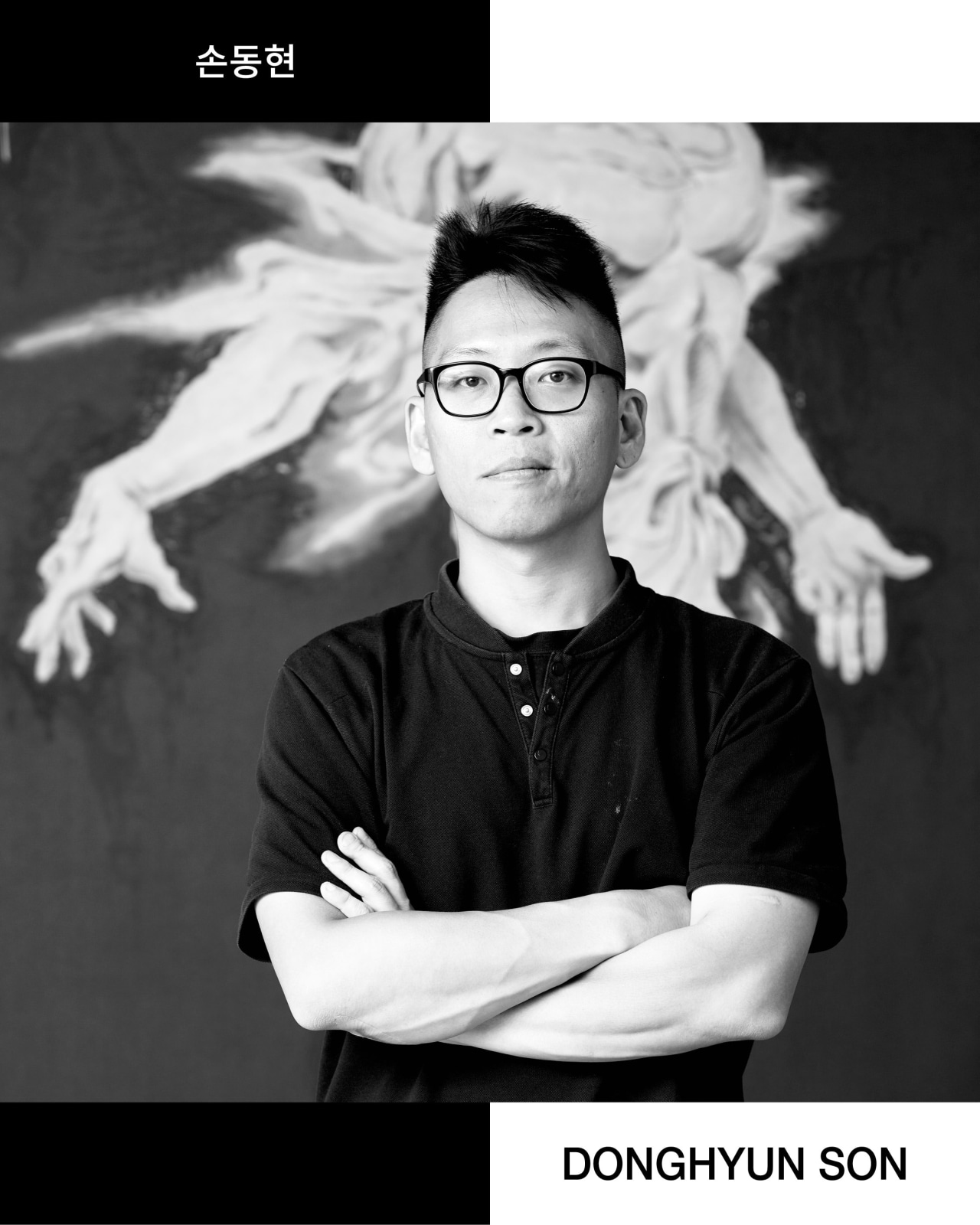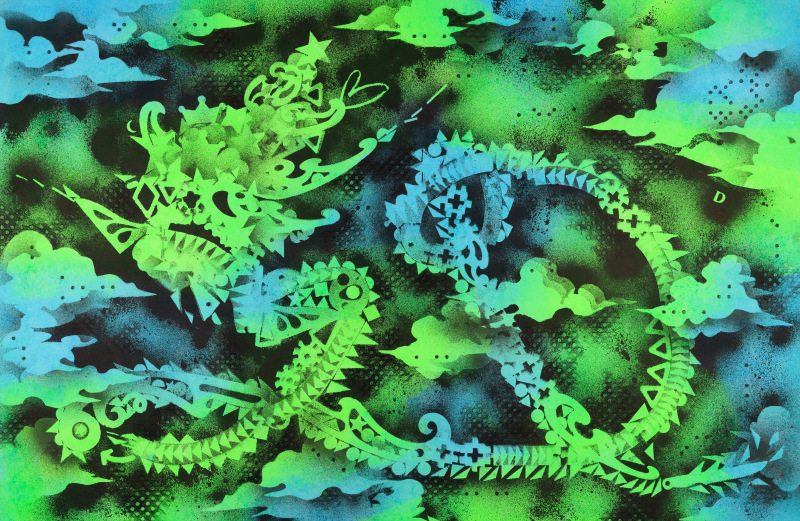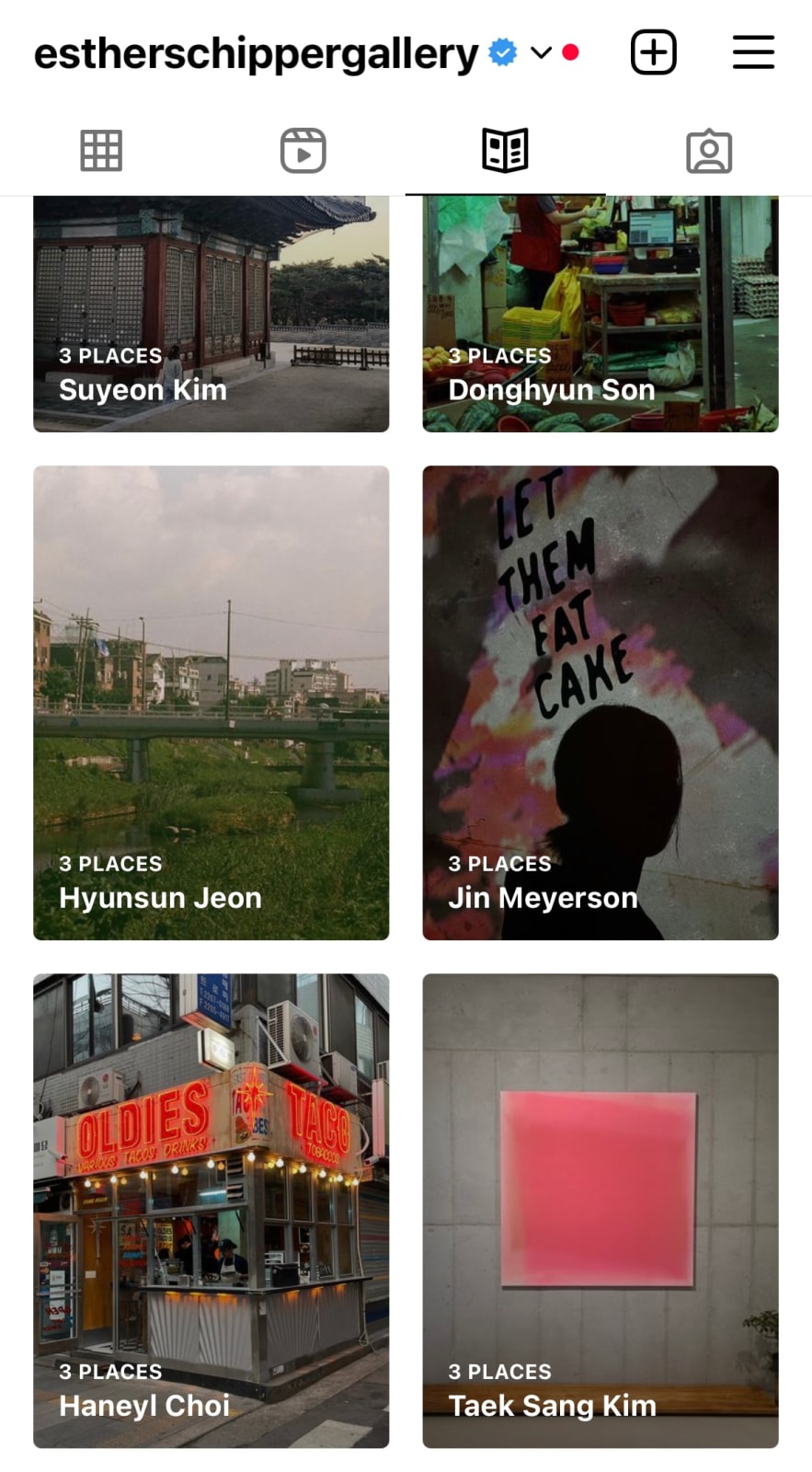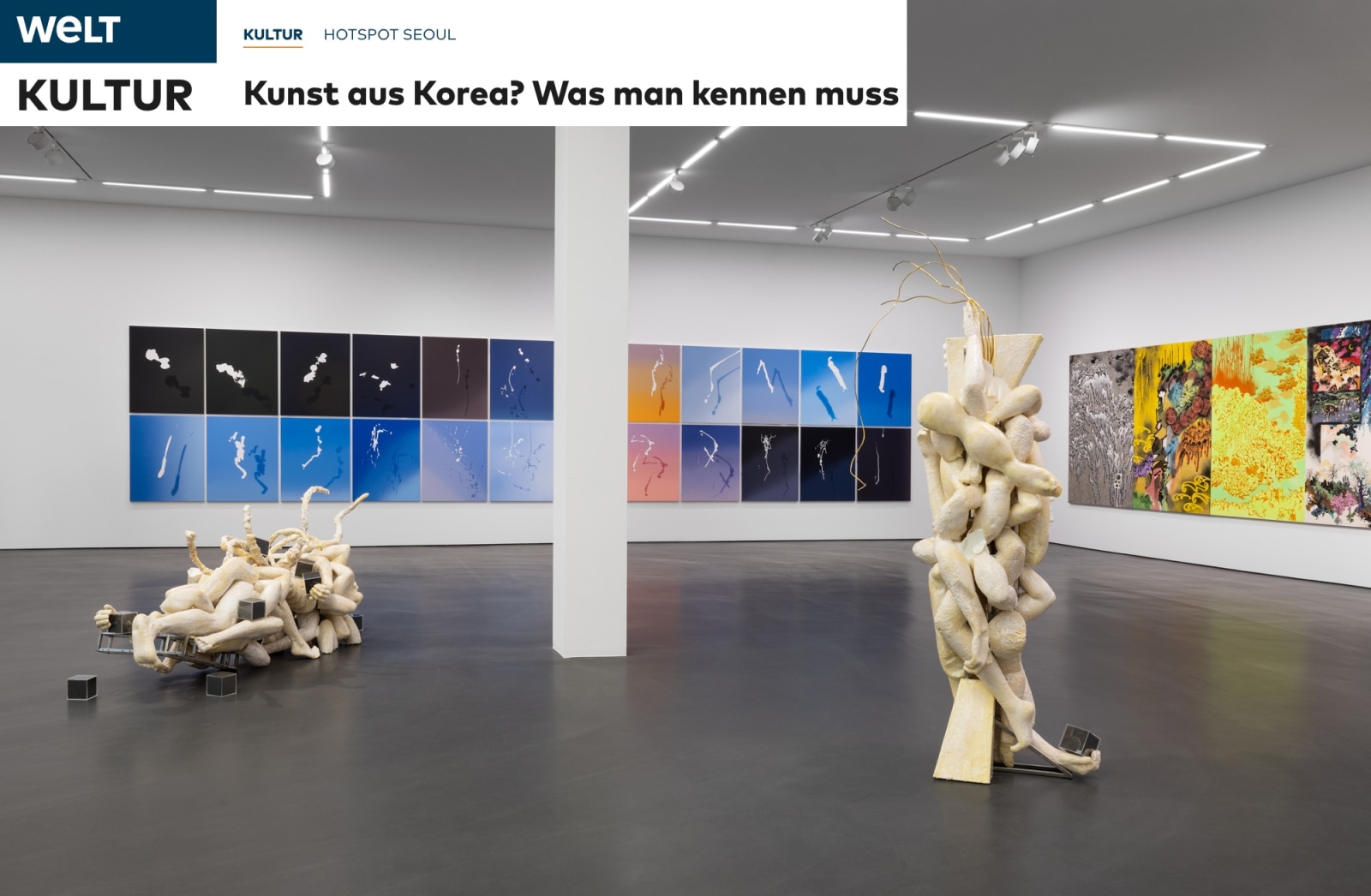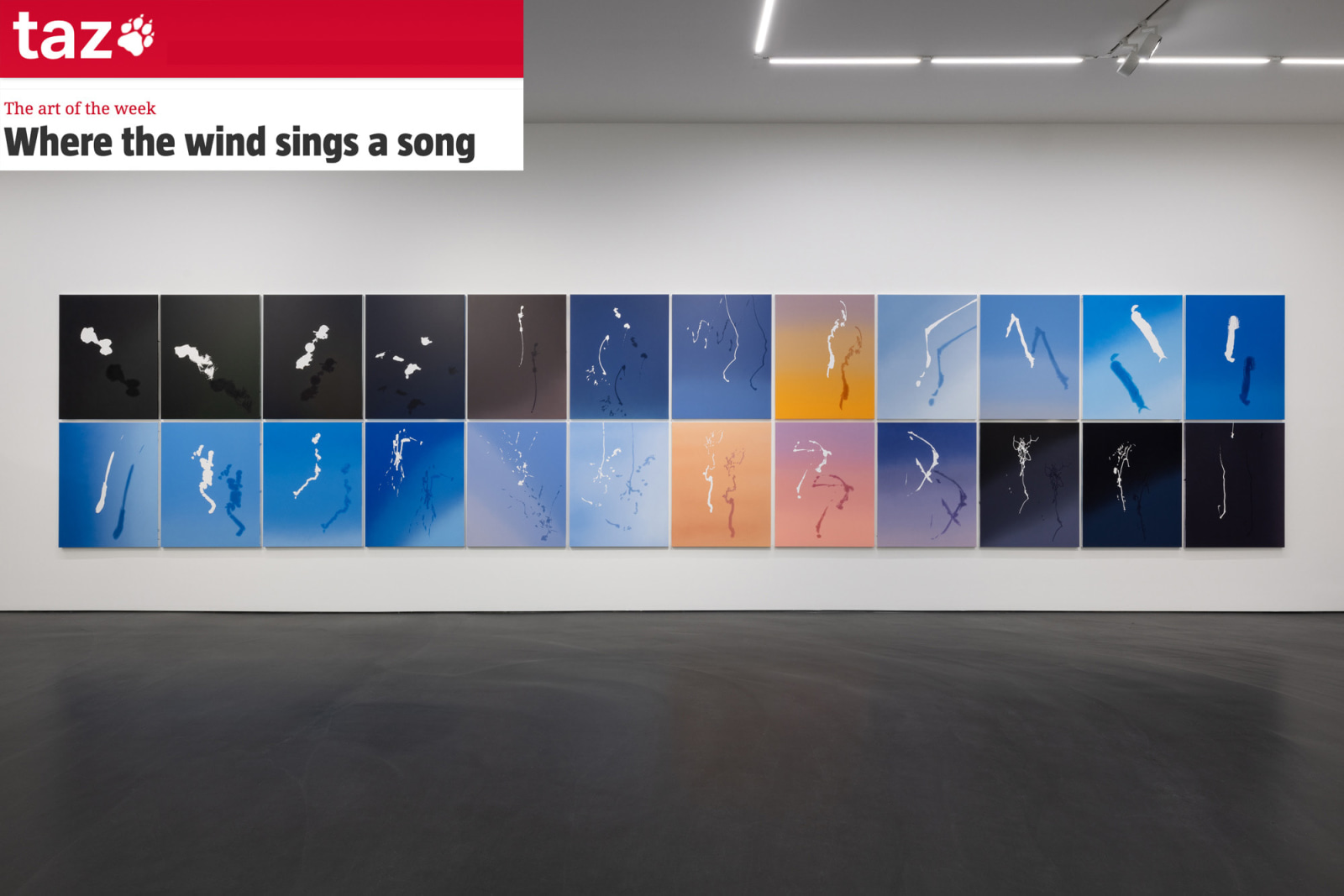Willkommen: Hier finden Sie die deutsche Fassung des Briefes aus Berlin
Letter from Berlin 한국어 버전을 보실 수 있습니다.Welcome to the Letter from Berlin! This summer we are bringing Korean art to Berlin with the two-part exhibition Dui Jip Ki currently on view in Berlin and in Seoul. Curated in close collaboration with our team in Seoul, we are very excited to present the work of these eight extraordinary artists from five generations to celebrate the gallery’s long-standing relationship with Korea, coming just shy of the first anniversary of the opening of our location in Seoul. This Letter from Berlin introduces the exhibitions, gives more background information on the artists with views from exhibitions, their studios and interviews. We also asked the artists to share a few of their favorite destinations in Seoul. These city guides will be featured on our Instagram account throughout the summer, but you can get a few of their tips here already. The first press is in and we end with a round-up! We hope you enjoy our Letter from Berlin! |
|
|

| Exhibition views: Dui Jip Ki / 뒤집기, Esther Schipper, Berlin, 2023
Photos © Andrea Rossetti | |
|
The work of all eight artists (seven in Seoul) connects in specific ways to the rich history of Korean contemporary art. Engaging critically with social and political ideas, employing alternative conceptual strategies, addressing subverted identities and parallel histories, or renewing traditional techniques and materiality, the works in Dui Jip Ki can be taken as an aesthetic journey of origin, development, and emergence.
The exhibition’s title, Dui Jip Ki, a term taken from an action and its corresponding associations, relates to the heterogeneity of artistic practices on view. In Korean the act of flipping something over to the other side is referred to as 뒤집기, Dui Jip Ki, and has multiple applications; it can be said of something domestic, such as turning over a pancake, but may also refer to a change of mind, an opening to alternative ideas. It is also the term used in traditional Korean wrestling for turning and pinning down an opponent through back-breaking strength to claim victory.
|
|
|

| Exhibition views: 뒤집기 / Dui Jip Ki, Esther Schipper, Seoul, 2023
Photos © Sangtae Kim
| |
|
The established narrative of the development of Korean culture during the last fifty years has been characterized by dichotomies. The social-political origin of contemporary Korea and contemporary art within Korea is formed by oppositional contrasts such as North vs. South and Abstraction (Dansaekhwa) vs. Social Realism (Minjung). The two dominant schools of postwar Korean art, Dansaekhwa and Minjung, have also been posed within this framework.
Dansaekhwa emerged in the early 1970s as the Korean iteration of the global phenomena of post-war monochrome painting but with a distinct emphasis on the meditative aspects at the core of its physical processes and conceptual intention. Drawing on philosophical notions of action and non-action, Dansaekhwa artists presented their practice as inherently East Asian.
Minjung, formed in the late 1970s in response to political developments and to the perception of Dansaekhwa as too unengaged with these harsh realities, drew on folk art and folk culture in order to produce works that could reach a wider audience. The Minjung artists’ practice of social realism depicted political and social struggles but also celebrated the resourcefulness and resilience of the people through depictions of diverse communities and the Korean landscape.
|
|
|
 | Presentation of works by Lee Bae
Exhibition view: Dui Jip Ki / 뒤집기, Esther Schipper, Berlin, 2023. Photo © Andrea Rossetti
| |
|
These binaries have ceased to be as important for younger generations and especially since the increasing international visibility and exchange in the early 1990s—with the 1993 Whitney Biennial exhibition in Seoul, the 1995 inauguration of the country’s pavilion at the 46th Venice Biennale and the first Gwangju Biennial also in 1995—Korean artists have largely broken with the essentialist and nationalist claims of the two earlier movements. Dui Jip Ki seeks to present the vividness of contemporary practices highlighting artists who have found ways to work within long established media of painting and sculpture in highly original and alternative ways.
|
|
|
The work of Lee Bae (b. 1956) represent a second generation of evolution within Korean contemporary art. His work employs elemental and alternative conceptual transformational strategies, creating a bridge between post-war monochrome painting and contemporary art. Lee Bae’s work honors the rituals and traditions of Korean folk culture and craft. Using wood, fire, and Hanji (Korean Mulberry paper) to produce sculpture, installation, drawing, and assemblage, charcoal represents a central transformational material in his practice.
|
|
|
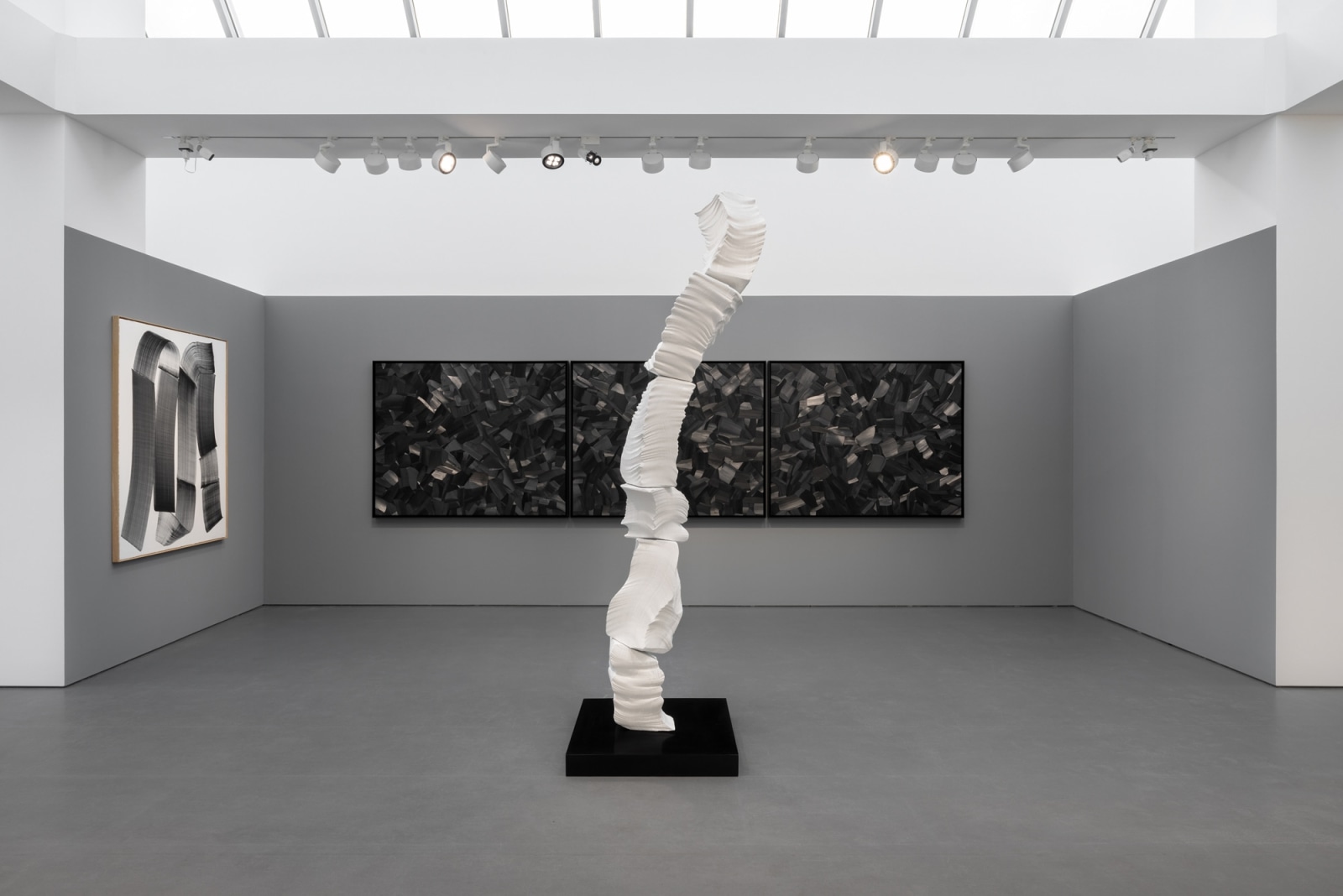 | Presentation of works by Lee Bae
Exhibition view: Dui Jip Ki / 뒤집기, Esther Schipper, Berlin, 2023. Photo © Andrea Rossetti | |
|
Charcoal has unique meanings in Korean tradition. It is believed that charcoal can dehumidify houses and ward off evil forces. When the first full moon of the lunar calendar rises, people would perform the ritual of “burning the moon house”, setting ablaze a sacred moon structure built up of pine branches. The charcoal carbonized by the burning of pine wood is considered a purifying substance with spiritual implications.
Relatively inexpensive, the medium of charcoal made it possible for Lee Bae to explore various aspects of its materiality. In his artistic practice, the artist who lived in France for an extended period of his life, found a way to connect with his cultural roots. |
|
|
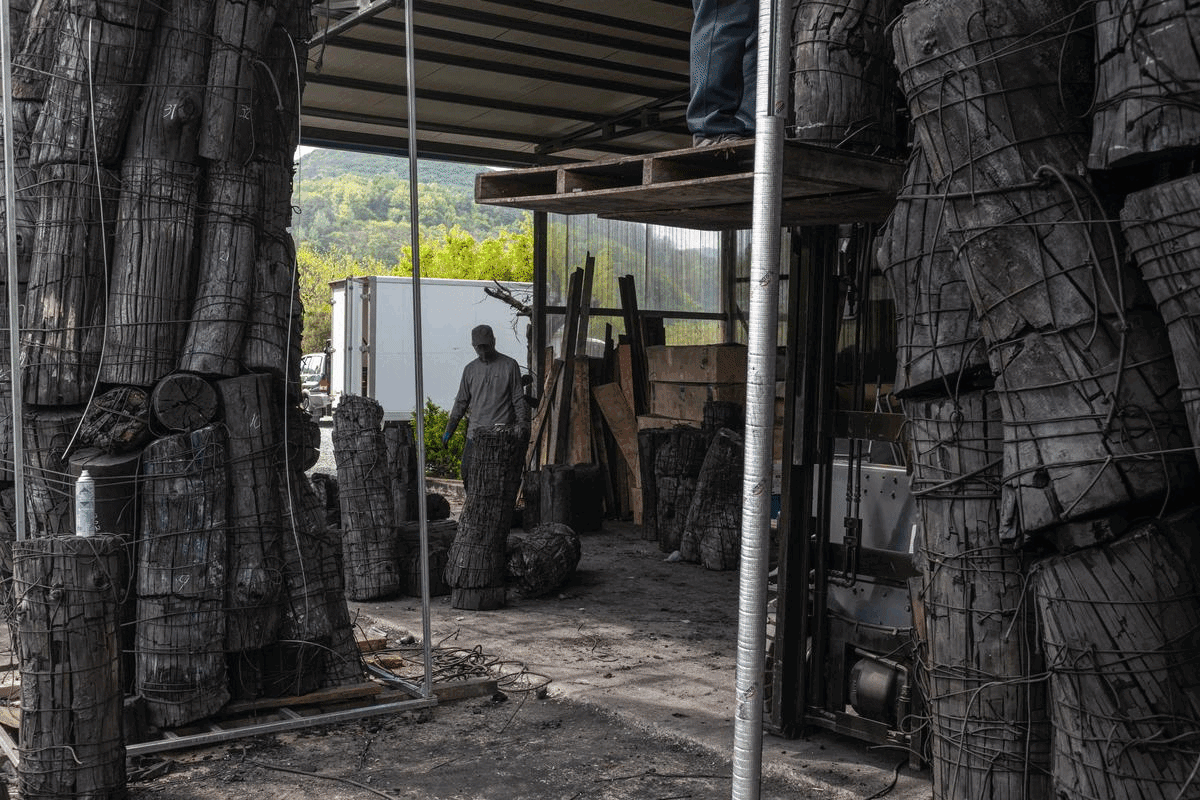 | Lee Bae studio views. Courtesy of the artist and Johyun Gallery. Photos © Studio Lee Bae
| |
|
The series of works entitled Issu du feu are paintings from charcoal on canvas that at first appears similar to a section of a huge bundle of tightly bound charcoal, smooth as if sliced by a sharp implement. In fact, they are created by aligning cut charcoal on the canvas, which are then grafted and polished. Hundreds of wood grain and growth rings made by nature and time fill the canvas, refracting light in various directions and in multiple angles.
Charcoal, which seemed to be simply black at first sight, gives rise to a myriad of optical expressions like an encyclopaedia of light. The work, evoking a wide range of images in the viewer’s minds, sensitively reacts to the entire spectrum of light, from the faintest to the brightest, to the subtlest shades and to people’s shadows. |
|
|
Lee Bae
Issu du feu 6y, 2002
Charcoal on canvas 175 x 140 cm Inquire
|
|
|
Hyunsun Jeon (b. 1989) has developed a unique pictorial language that employs a distinct chromatic palette with an emphasis on greens and blues, colors associated with Korean painting. Drawing on varied scales of representations, her formal vocabulary is suspended between symbolic geometry and suggestive landscape. Executed in watercolor, Jeon's paintings focus both on a material flatness (a smooth and often matte surface) but of representation itself. Her iconography includes shapes read intellectually and intuitively as three dimensional but with an artful two dimensionality that highlights the insistent flatness of her compositions.
The geometric forms in her paintings are often echoed in the three-dimensional structures in which she stages her works. |
|
|
 | Presentation of works by Hyunsun Jeon
Exhibition view: Dui Jip Ki / 뒤집기, Esther Schipper, Berlin, 2023. Photo © Andrea Rossetti
| |
|
A particularly significant and frequent motif is the cone. To Jeon the cone, a classical geometric shape that has also featured prominently in mathematics, became a stand-in for undecidability. It could appear flat or spatial, but to the artist it signals ambiguity in a broader sense. Amidst other specific motifs, a cone appeared simultaneously as important protagonist and unimportant blank. As Jeon has said: "It was like a black hole sucking in all the viewer’s effort to decipher the painting’s narrative, thus, the cone had a very clear reason for existence. A cone gradually became so important that it finally lost its function and disappeared, dispersing fragments and fractions of solid shapes all over."
|
|
|
Hyunsun Jeon
When You Believe, 2023
Watercolor on canvas 200 x 100 cm Inquire
|
|
|
Jeon's paintings are explorations of shifting shapes and forms that take on meaning only to shed it again. While Jeon draws on geometric shapes and everyday objects, her paintings also employ a formal language of simplified landscapes reminiscent of early digital imagery, sometimes even alluding to pixelated glitches. |
|
|
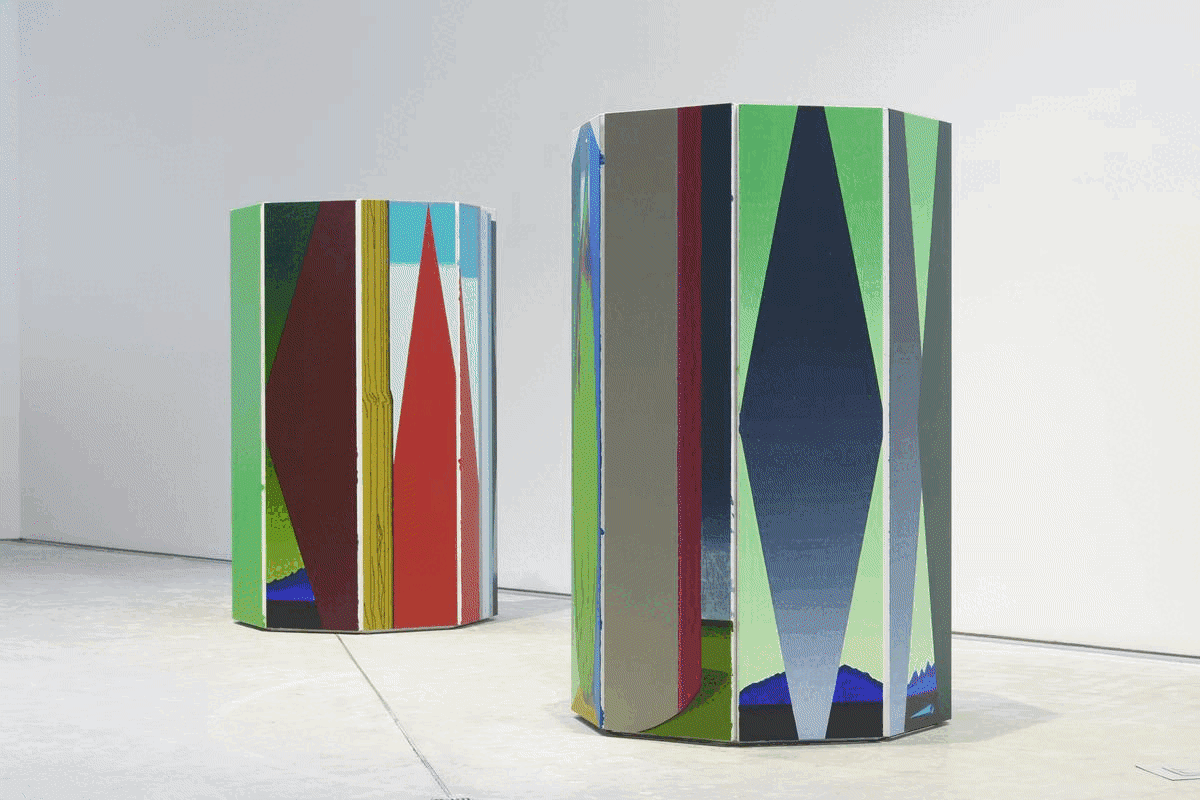 | 1. Exhibition view: Art Spectrum 2022, Leeum Samsung Museum of Art, Seoul (2022). Courtesy of the artist and Leeum Samsung Museum of Art, Seoul. Photo © Sangtae Kim. 2. Studio view: The artist and her son (2023). Photo © baufoto. 3. Exhibition view: Meet me in the Middle, Gallery2, Seoul (2022). Courtesy of the artist and Gallery2, Seoul. © Sangtae Kim. 4. Exhibition view: From Fig to Cone, Gallery2, Seoul (2020). Courtesy of the artist and Gallery2, Seoul. Photo © Sangtae Kim. 5. Exhibition view: Parallel Paths, Alternative Space LOOP, Seoul (2018). Courtesy of the artist and Alternative Space LOOP, Seoul. Photo © Yoon Byoungjoo | |
|
Taek Sang Kim (b.1958) as well represents already a second generation of evolution within Korean contemporary art. Taek Sang Kim engages with a transformational process of water, air, fabric, and paint to create richly saturated paintings that don’t give away their sophisticated conceptual environmental process, eventually arriving at pure and simple autonomous form.
|
|
|
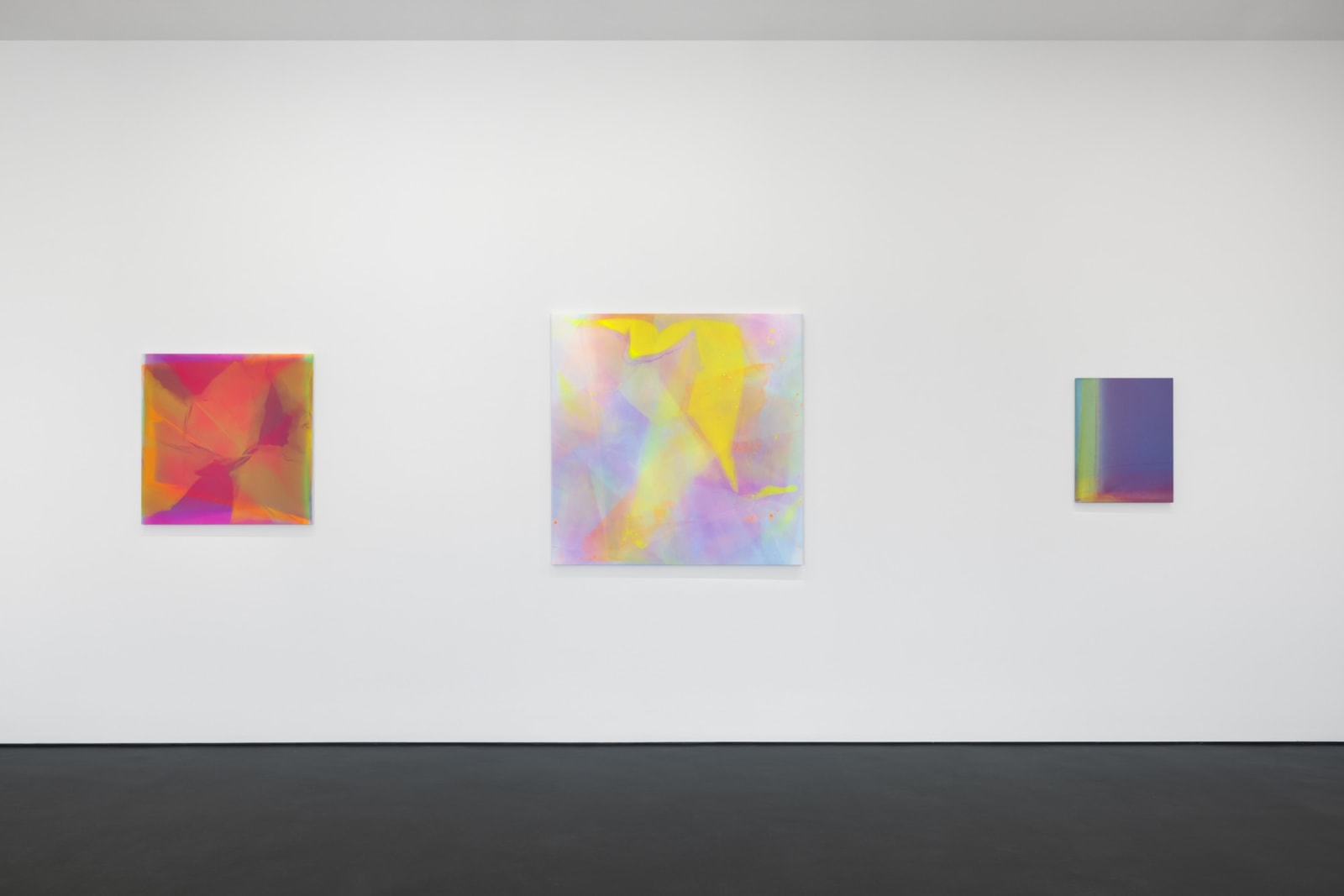 | Presentation of works by Taek Sang Kim
Exhibition view: Dui Jip Ki / 뒤집기, Esther Schipper, Berlin, 2023. Photo © Andrea Rossetti
| |
|
Drawing on an observation of color in nature, over the last thirty years Taek Sang Kim has developed a distinct practice of creating luminous paintings through a process of repeatedly staining the canvas. Kim had observed the clarity and depth but also colorfulness of lakes in photographs of the US National Park Yellowstone. Subsequently, the artist longed to find a way to represent in painting such color, not as fixed entity but in light, as he has put it.
|
|
|
Taek Sang Kim
Breathing light - Violet Green 23-1, 2023
Water, acrylic on canvas
85,5 x 86 x 2,7 cm
|
|
|
For his process, Kim has constructed flat framed basins on the floor in which the fabric is held and doused with diluted color. The color pigment dissolved in the watery solution settles as the water vaporizes. Edges and lines form by dissipating water, not the artist’s hand. Depending on wind, sun and temperature in the studio and also on the angle of the basins’ edges, the effects vary in each case. This process is repeated many times. Each exposure ads a unique color, until the work is finished, and the color lightly fixed with a medium.
|
|
|
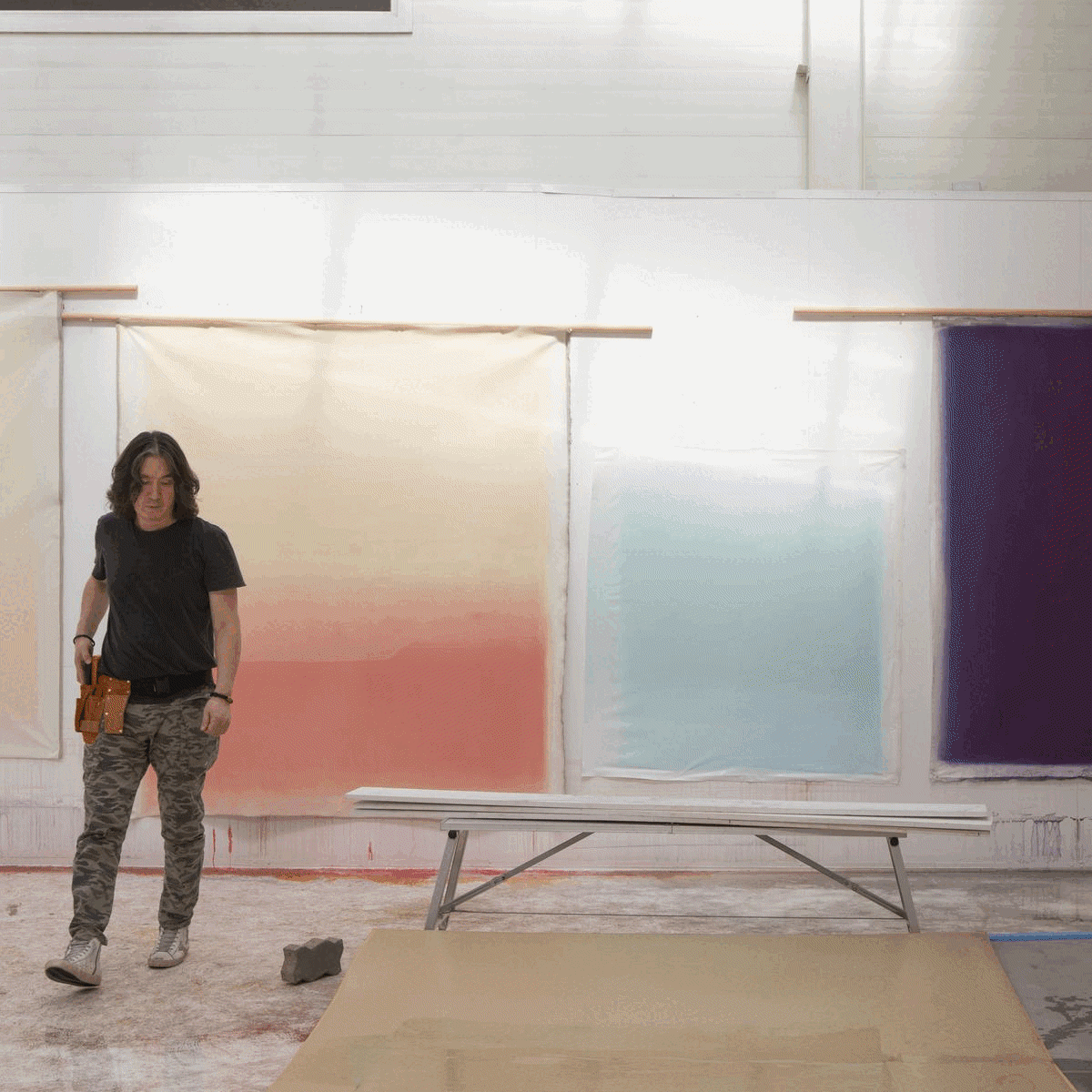 | 1- 4.Taek Sang Kim studio views. Photos © Taek Sang Kim Studio. 5 - 7. Exhibition view: Four Season Exhibition Project, Gallery Aso, Daegu, Korea (2017-2018). Photos © Lee Sumin
| |
|
The result is a painting of strata of color interwoven as the pigment of subsequent baths has settled in the fibers of the canvas. Because of this process, there is no over/under layering and therefore any notion of a linear, temporal application is replaced by the experience of near miraculous simultaneity and beauty. |
|
|
The most senior artist in the exhibition, Hong Joo Kim (b. 1945) has remained since the beginning of his artistic career outside of the two dominant postwar art movements. His practice is experimental and varied and has gone through physical and conceptual explorations that include performance, assemblage, sculpture, installation, eventually returning to painting. On view in Berlin and in Seoul are works from his series of meditative paintings of abstract and plant forms that are both a conceptual gesture and a celebration of craftsmanship.
|
|
|
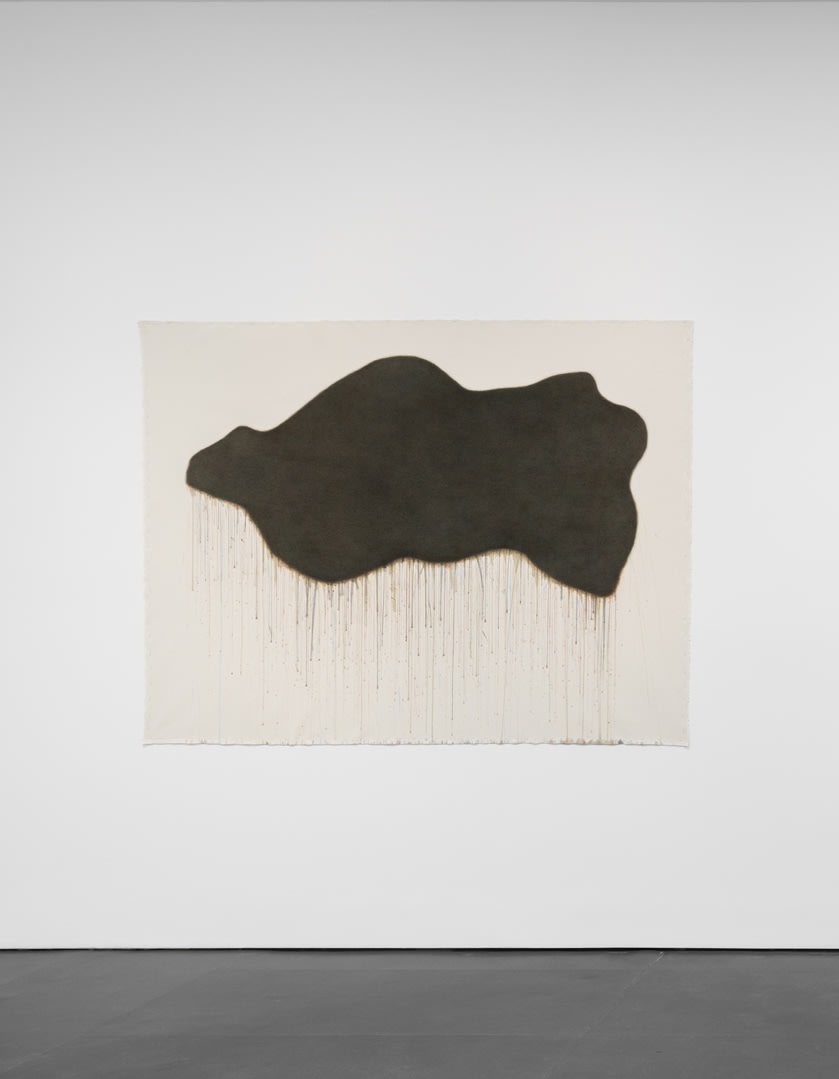 | Hong Joo Kim, Untitled, 2020, acrylic on canvas, 158 x 205,5 cm
Exhibition view: Dui Jip Ki / 뒤집기, Esther Schipper, Berlin, 2023. Photo © Andrea Rossetti | |
|
The large-scale untitled work installed in Berlin is characteristic of Hong Joo Kim's most recent practice which since 2010 has increasingly foregrounded tactility. While the artist employed small brushes even in his early surrealist-inspired figurative works from the 1970s, the focus of using this technique gained a new significance. From around 2010, Hong Joo Kim became deeply immersed in the sensory experience of using a brush with a few bristles, specifically focusing on conveying the tactile sensation that arises when the brush touches the surface of the canvas.
As a result, the importance of the representational form on the canvas diminished, and the works became more abstract. Fragmentary motifs emerged that hover between representation and abstraction, even as the ambiguity of form is not one of the artist's main concerns. His ongoing work in conveying the tactile sensation through his works, which is experienced physically while painting, continues to be the major theme. |
|
|
Hong Joo Kim
Untitled, 2020
Acrylic on canvas 158 x 205,5 cm Inquire
|
|
|
Produced by the Korean Artist Digital Archive Project, the following 25-minutes video gives a comprehensive and engaging overview of Hong Joo Kim's prolific artistic practice.
|
|
|
Suyeon Kim (b. 1986) employs a wide variety of layered conceptual strategies to create her paintings. She often begins by creating three-dimensional objects printed from photographs, which she in turn transforms “back” into a two-dimensional form, highlighting the hybrid state of painting as image and object. Sign language, collective memories of her community, and specific emotional and physiological experiences are categorized and turned into paper sculptures, that become direct reference points for paintings. Most recently she has conceived of an environmental intervention to produce paintings by suspending a brush and letting the wind move it across a page, which she later scans and uses as the framework and structure of the composition. |
|
|
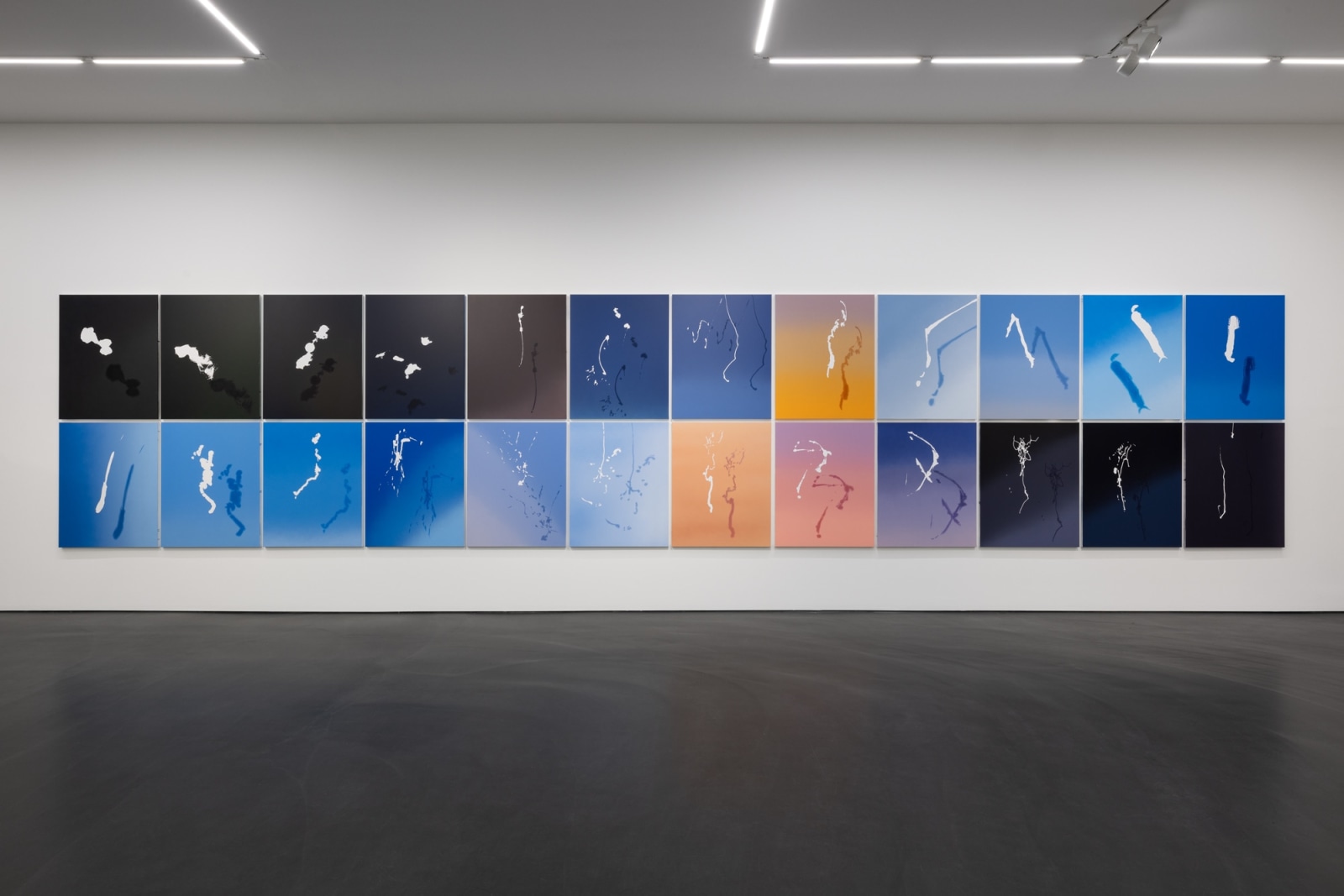 | Presentation of works by Kim Suyeon
Exhibition view: Dui Jip Ki / 뒤집기, Esther Schipper, Berlin, 2023. Photo © Andrea Rossetti
| |
|
Suyeon Kim's work belongs to a twenty-four part series of works documenting meteorological conditions in a twenty-four hour period. The artist used various tools, among them brushes, pens, and oil sticks, which were moved by the wind to produce indexical marks relating to its speed and direction. These marks were subsequently transferred onto the canvas.
The twenty-four works are a record of the wind and the colors of the sky on the Vernal Equinox (March 21), one of two days in the year when the Sun is exactly above the Equator and day and night are of equal length. As part of her data collection, Kim kept hourly anemographic readings throughout the 24-hour period, on the hour, every hour such as a data and tool-based taxidermy of nature.
|
|
|
Suyeon Kim
SE23032112, 2023
Acrylic on canvas 100 x 80,3 cm Inquire
|
|
|
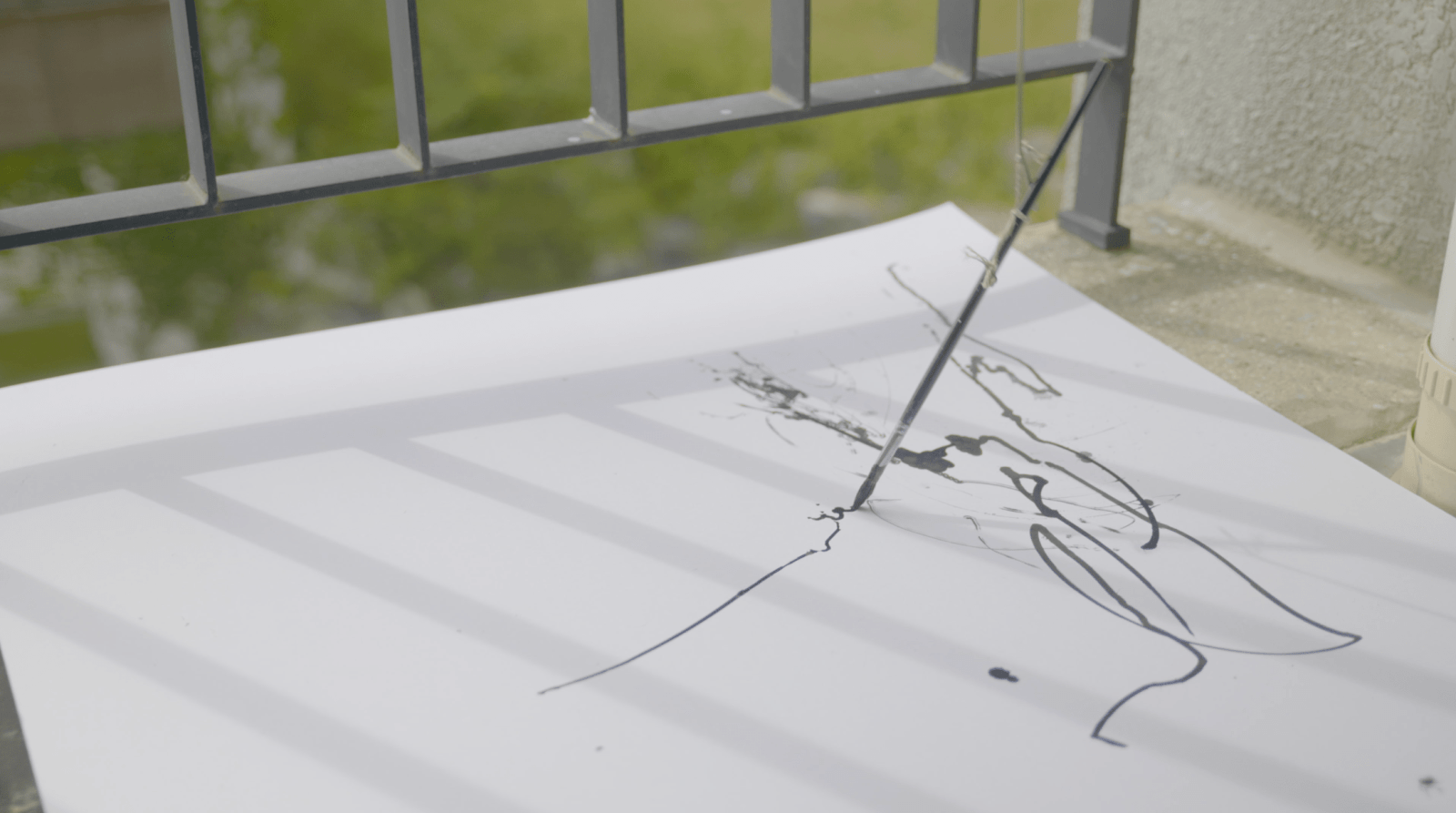 | Suyeon Kim studio view. Photo © Riveruns Official | |
|
Suyeon Kim has been exploring the meteorological realm through her works for some time. Despite centuries of knowledge and technological advancements, the changing weather has remained elusive and ephemeral as the wind. That is, Kim recognized that all around her, wind blows where it wishes and she could hear its sound, but she could not ascertain where it came from or where it was going. She collected the intangible pneuma-object—the Greek word pneuma meaning literally wind, but also breath or spirit—through its transient and momentary representations in the movement of a self-made instrument of visual record-keeping. |
|
|
Haneyl Choi (b.1991) is a pioneer of sculpture and queer identity as one of the first openly gay artists in Korean contemporary art history. Constructed from ready-made found objects, printed plastics, coded symbols, digital and video elements, Choi's work constantly transcends the boundaries of what it means to be a sculptor. Choi’s work is generous in its expansive inclusion of almost every material he can get his hands on. Ready-made found objects, 3-d printed plastics, coded symbols, and QR codes all play a role in his current practice.
|
|
|
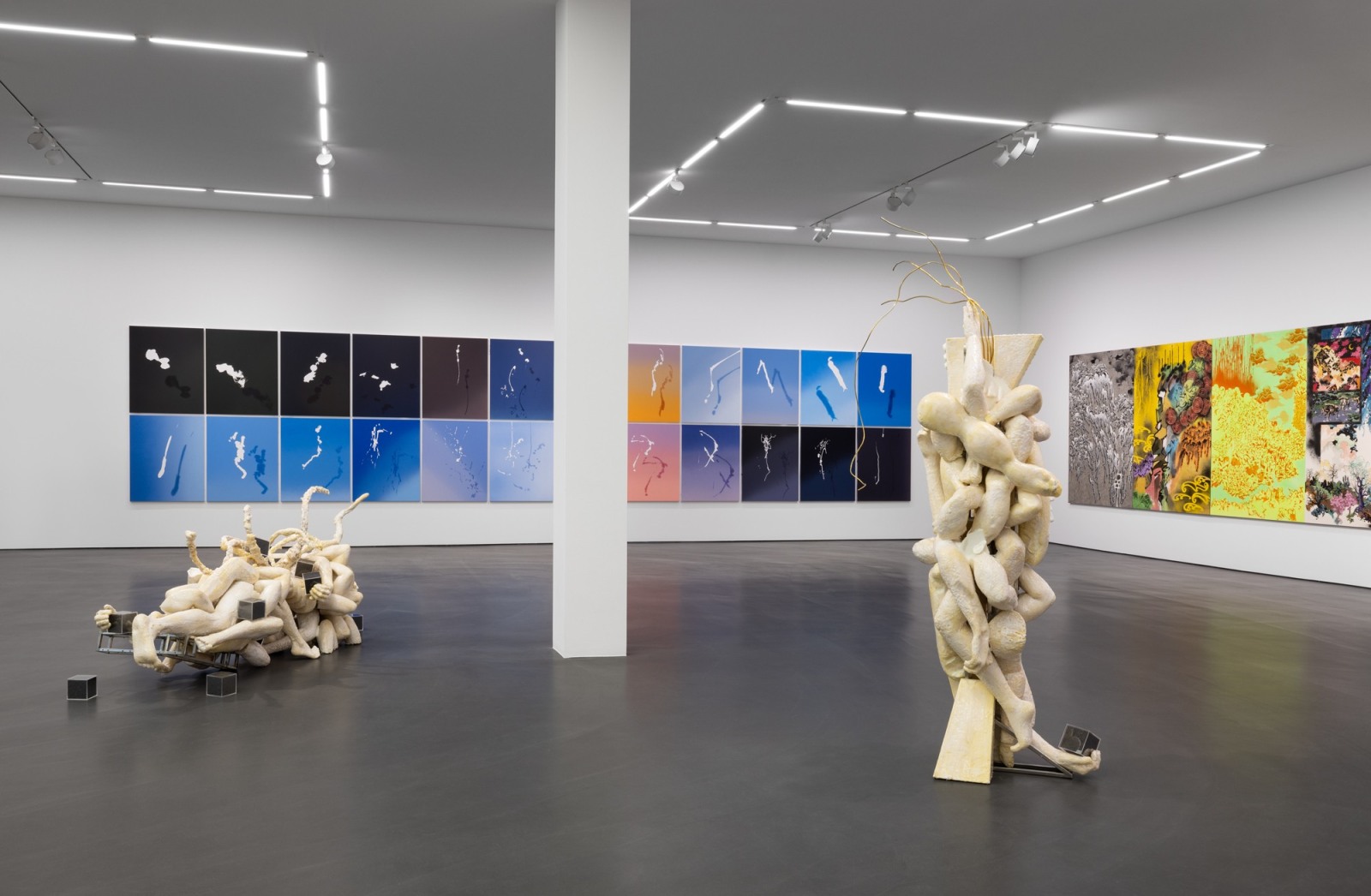 | Exhibition view: Dui Jip Ki / 뒤집기, Esther Schipper, Berlin, 2023. Photo © Andrea Rossetti
| |
|
Haneyl Choi's two sculptures exhibited in Berlin consist of an assemblage of disparate elements joined in an elongated construction: among them various human limbs, simplified geometric shapes such as discs and wedges, and spiraling protrusions resembling viscid intestines or metal spikes.
The body parts, muscular arms and legs, are arranged in a lively entanglement that suggests scenes of touching and exude a charged atmosphere full of sensual, erotic energy. Among the tightly constructed composition of fragmentary limbs, the fused geometric shapes represent small abstract interruptions, as does the visible support structure. In addition, a number of small black squares are placed in and around the off-white elements. |
|
|
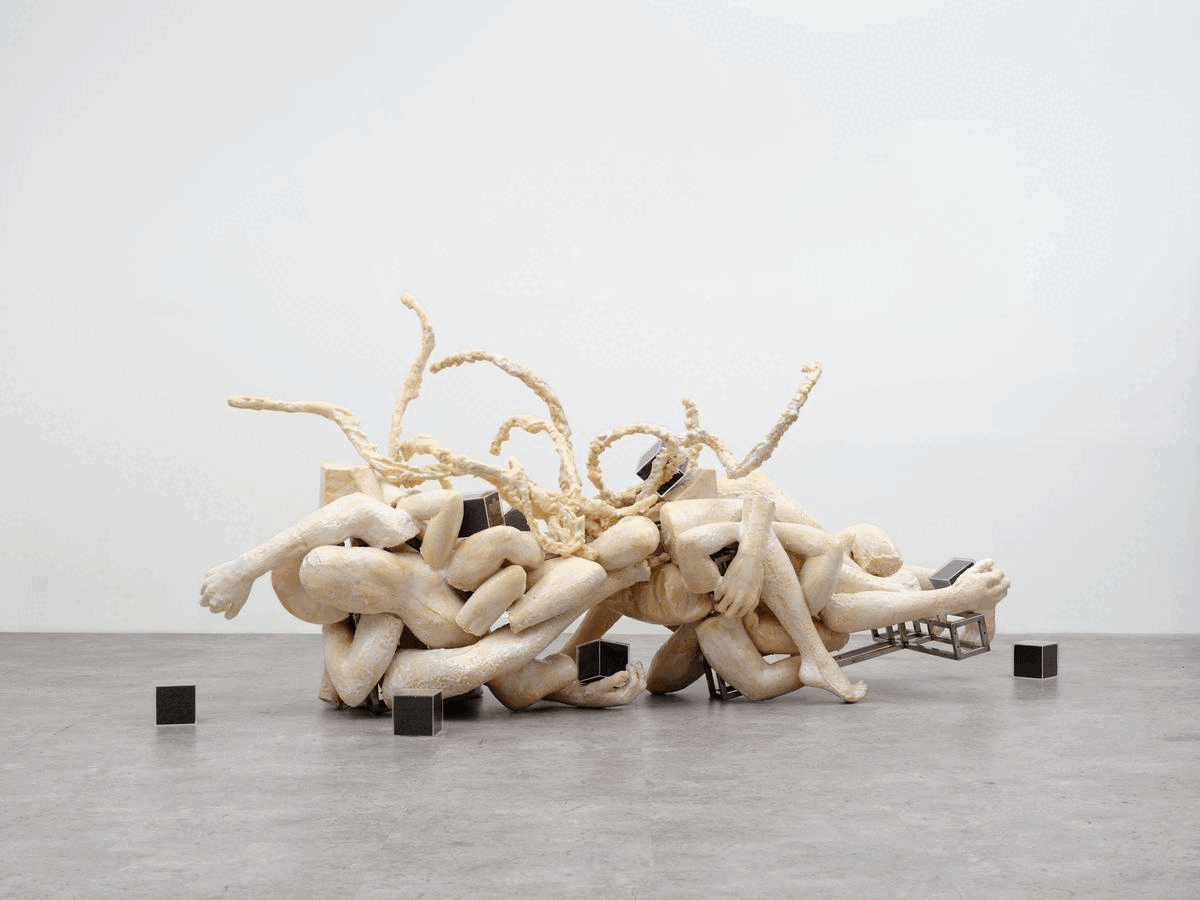 | Haneyl Choi. Physically: vibe, humor, hormone, pheromone, stink, body language, 2023, expandable foam, silicone, urethane, urea resin, acrylic, styrofoam, steel frame, bronze pipe110 x 90 x 230 cm (excluding intestines). Courtesy the artist, Gallery 2, Seoul, and Esther Schipper, Berlin/Paris/Seoul. Photo © Sangtae Kim | |
|
 | Haneyl Choi, Physically: vibe, humor, hormone, pheromone, stink, body language, 2023, expandable foam, silicone, urethane urea resin, acrylic, styrofoam, steel frame, bronze wire, 180 x 70 x 80 cm (excluding wire). Courtesy the artist, Gallery 2, Seoul, and Esther Schipper, Berlin/Paris/Seoul. Photo © Sangtae Kim
| |
|
The sculptures are from a body of work exploring the human form with a new-found urgency. To Choi the isolation experienced during the pandemic also highlighted the importance of intimate physical contact. As the artist noted:
"The moment when two masses/bodies embrace and merge into one, when bodies twist and muscles entangle in union, is a physical moment of the fusion of two breaths becoming one, two droplets of sweat merging into a single stream, different densities of bodily fluids blending into something new, and the internal and external meeting to become pleasure. The cyclical process of attempting to overcome the resistance and unconscious interaction of the other person when I try to control their body is a physical moment that reminds me that humans are still human." |
|
|
Haneyl Choi
Physically: vibe, humor, hormone, pheromone, stink, body language, 2023
Expandable foam, silicone, urethane urea resin, acrylic, styrofoam, steel frame, bronze wire 180 x 70 x 80 cm (excluding wire) Inquire
|
|
|
A major theme of Choi's work is the engagement with ideas of masculinity, subverted queer identity, art history, neo-futurism, and deviancy within constrained domestic standards of normalcy. Akin to our contemporary world of free association data accessibility via infinite feeds of content, Choi’s network of thoughts and ideas are overlaid, creating output layered with absurdities, and unflinching boundless humor. |
|
|
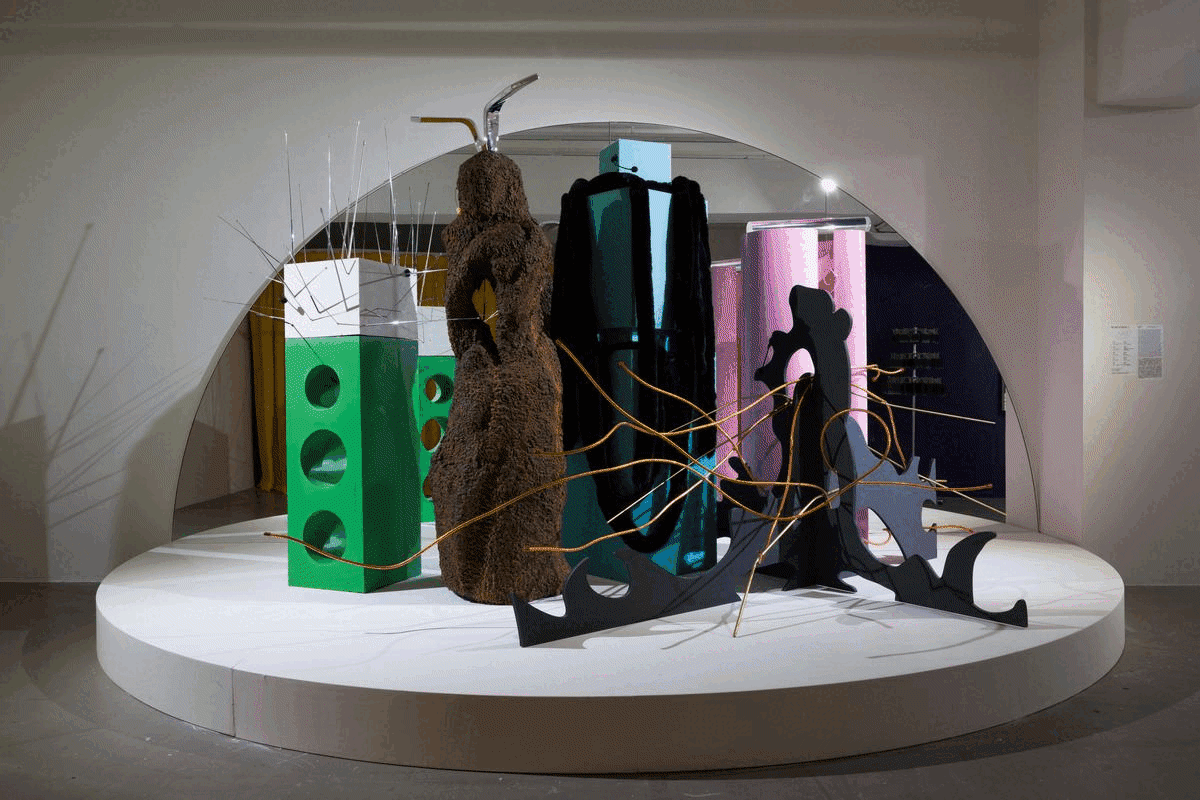 | 1. Haneyl Choi, Move, Common Dream: Be a Great IDOL, 2022, sponge, expanded polystyrene, plywood, 3D printed solid, plaster, approx. 350 x 350 x 220 cm, commissioned by Parasite, Hong Kong. Photo © Felix S.C. Wong, Parasite, Hong Kong. 2. Sculptural IDOL: <433 Three minutes, fourty-four seconds>, 2022, steel, mirror(acrylic), styrofoam, chrome on steel, sponge, various size. Photo © Daegu Art Museum, Daegu. 3. Exhibition view, Manner, P21, Seoul; Gallery2, Seoul (2022). Courtesy of the artist and Gallery2, Seoul, and P21, Seoul. Photo © Sangtae Kim. 4. T2, 2022, resin on kart, 150 x 190 x 200 cm. © Sangtae Kim, P21, Seoul
| |
|
Born outside of any data record, Jin Meyerson (b. 1972) is one of a vast multitude of displaced Korean adoptees that face severed personal histories and internal crises, and domestic prejudice on their return. For Meyerson, experiences of the loss of his birth records, his abandonment at a public market in 1975, and his eventual adoption in 1976 from an Incheon orphanage to a Jewish-American/Swedish-American family, transplanting him into American culture have formed the engine and basis of his work.
|
|
|
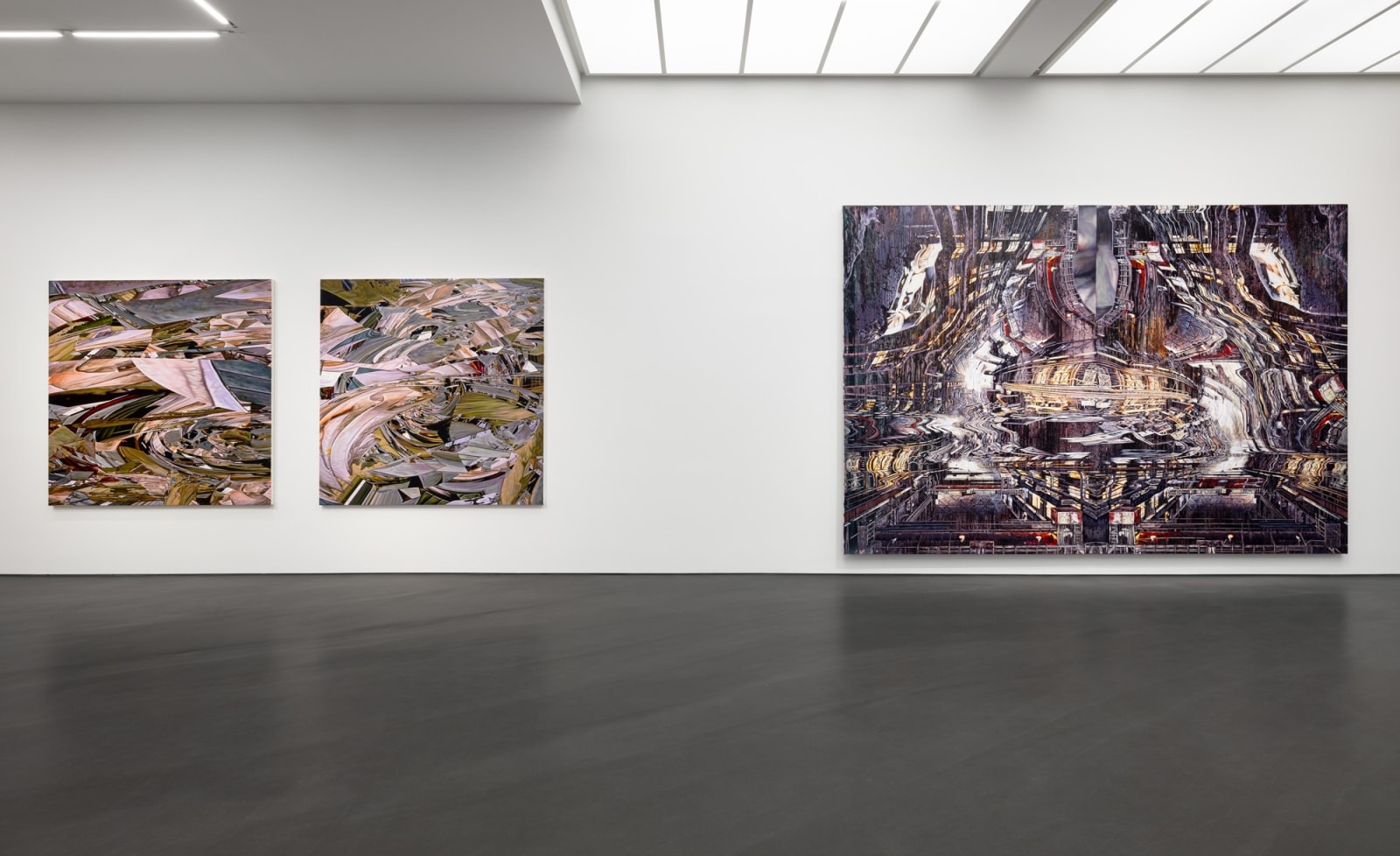 | Left: Jin Meyerson, Ascendant 2.0, 2023
Center: Ascendant 1.0, 2023
Right: STAGEDIVE, 2015
Exhibition view: Dui Jip Ki / 뒤집기, Esther Schipper, Berlin, 2023. Photo © Andrea Rossetti
| |
|
An early pioneer of frontier optics, Meyerson began employing early CG digital output as a sketching tool in 1996, creating neo-pop paintings of American culture where he sampled images of gross aspects of Americana, subjecting them to severe digital distortion and then representing them to the very culture they were drawn from. Meyerson’s paintings bridge the established languages of abstraction and figuration, drawing from critical conversations about crisis, recovery, and renewal. |
|
|
Jin Meyerson
Ascendant 2.0, 2023
Oil and acrylic polymer on canvas 190 x 190 cm Inquire
|
|
|
Ascendant is from a new body of work related to the artist's interest in programming. Drawing on his fascination with the future, he has explored the concept of "retrocausality" present both in parapsychology and quantum physics. Retrocausality refers to the notion of backward causality, that is, effects that precedes its cause in time and therefore impacting an earlier moment.
For Ascendant Meyerson employed a dual reflective image and animation program by using the scans and sources of his earlier séance paintings to create videos of their potential futures. To the artist, painting already inherently partakes of this effect, as Meyerson notes: "The inherent time consumption of making a painting, reverses the flow of narrative or linear time, pulling the forecasted futures back into the present." A first cycle of paintings entitled Descendant were defined solely by curated glimpses of the videos. This new series, entitled Ascendant, engages with a superimposition of editing on top of the videos and adds additional layers of perception.
A series of new paintings are currently on view at Rockefeller Center in New York.
|
|
|
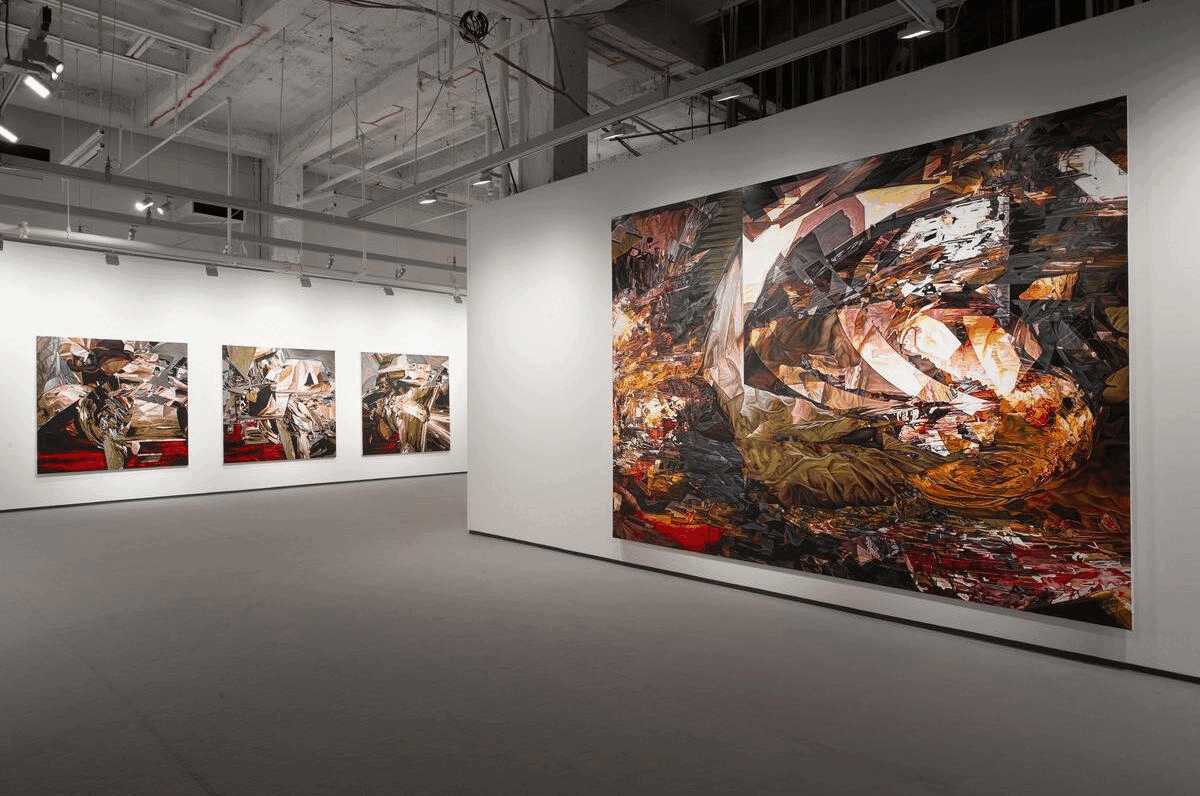 | 1 - 2. Exhibition view: Origin, Emergence, Return, Rockefeller Center, New York (2023). Courtesy of the artist and Johyun Gallery, Busan. Photo © Jin Meyerson Studio. 3 - 4. Studio views, Courtesy of the artist. Photos © Jin Meyerson Studio
| |
|
Donghyun Son (b. 1980) employs a deliberately eclectic combination of formal and conceptual themes in his work. His practice veers imaginatively between Eastern and Western aesthetic sensibilities, at times using the basics of oriental landscape painting to deconstruct it.
Donghyun Son has long focused on combining a broad range of pictorial languages and compositions, creating juxtapositions between the visual idioms of manga, comics, and graffiti, and historical iconography such as courtly portraits, hanging scrolls or multi-part screens. Son first began taking sections and fragments from a classical work from East Asian painting and reinterpreting them through contemporary drawing and writing techniques in 2020 with his work Early Spring, based on the eponymous early 11th century landscape painting by Guo Xi. |
|
|
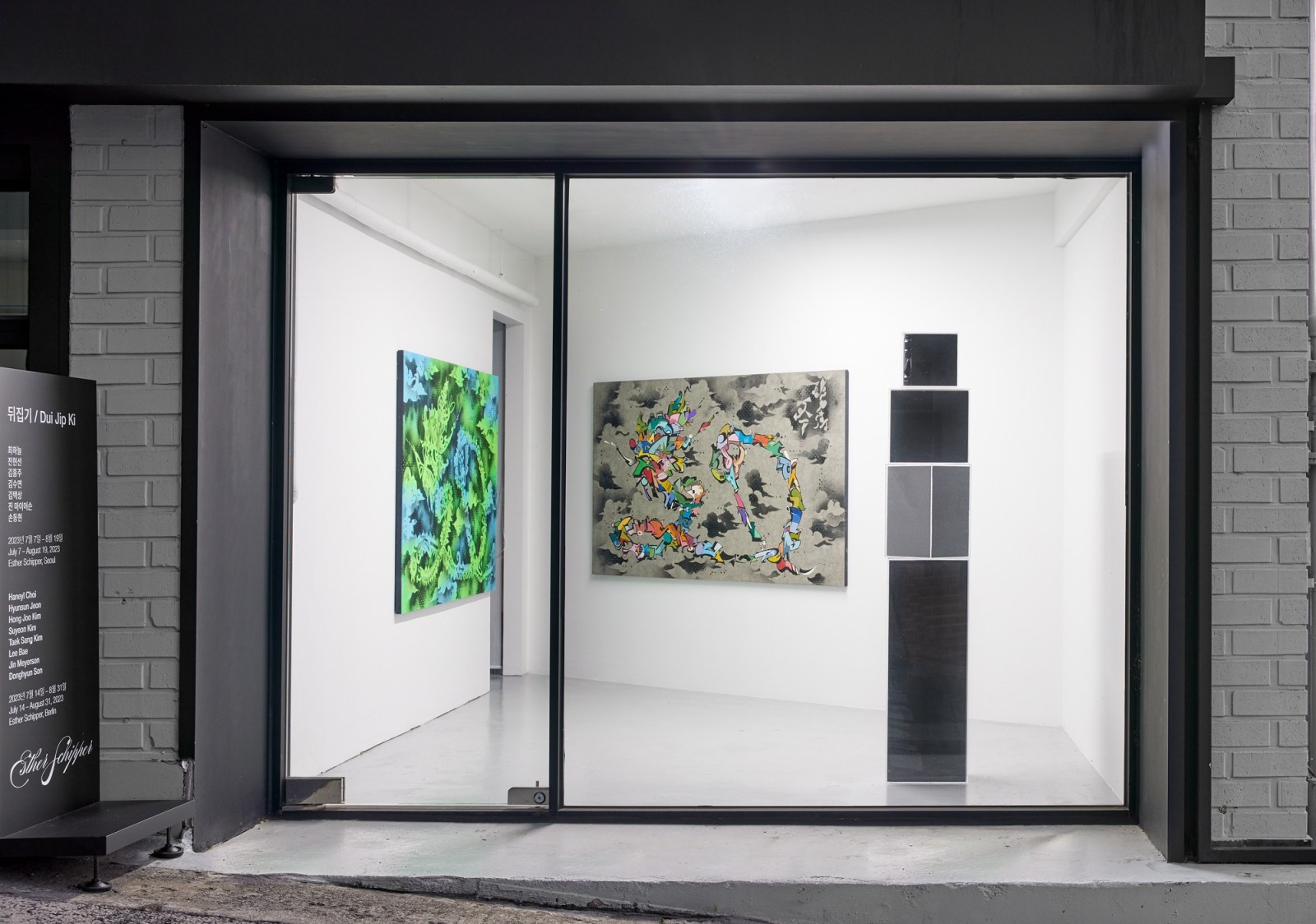 | Exhibition view: 뒤집기 / Dui Jip Ki, Esther Schipper, Seoul, 2023. Photo © Sangtae Kim
| |
|
Donghyun Son’s paintings on view in Seoul are from a series of unique works drawing on a 20th century work, Lee Ungno (Yi Eung-no) calligraphic sign for "dragon". Son has reimagined a classic example of the long tradition of refinement in ink calligraphy, using a style and painterly technique associated with a specific contemporary pictorial language. The work uses stenciled shapes to render the motif. |
|
|
Donghyun Son
Blue and Green Dragon, 2023
Ink and acrylic ink on paper 117 x 180 cm Inquire
|
|
|
Donghyun Son’s paintings in Berlin are from a series of unique works drawing on a famous historical work, Fan Kuan’s Travelers Among Mountains and Streams from the Song Dynasty, dated around to the early 11th century. Each panel in the ten-piece series takes a motif from the composition and re-imagines it in a novel painting technique, in effect deconstructing a classical masterwork and reimagining sections in a modern painterly idiom.
Each panel utilizes a distinct material and technique, often with specific associations. This work uses crumpled paper sprayed with ink to depict the texture of mountains and rocks and acrylic ink applied through the back using the Baechae technique (a traditional Korean painting technique where ink is slowly applied from the back of the paper or fabric to create subtle color effects and a smooth surface).
|
|
|
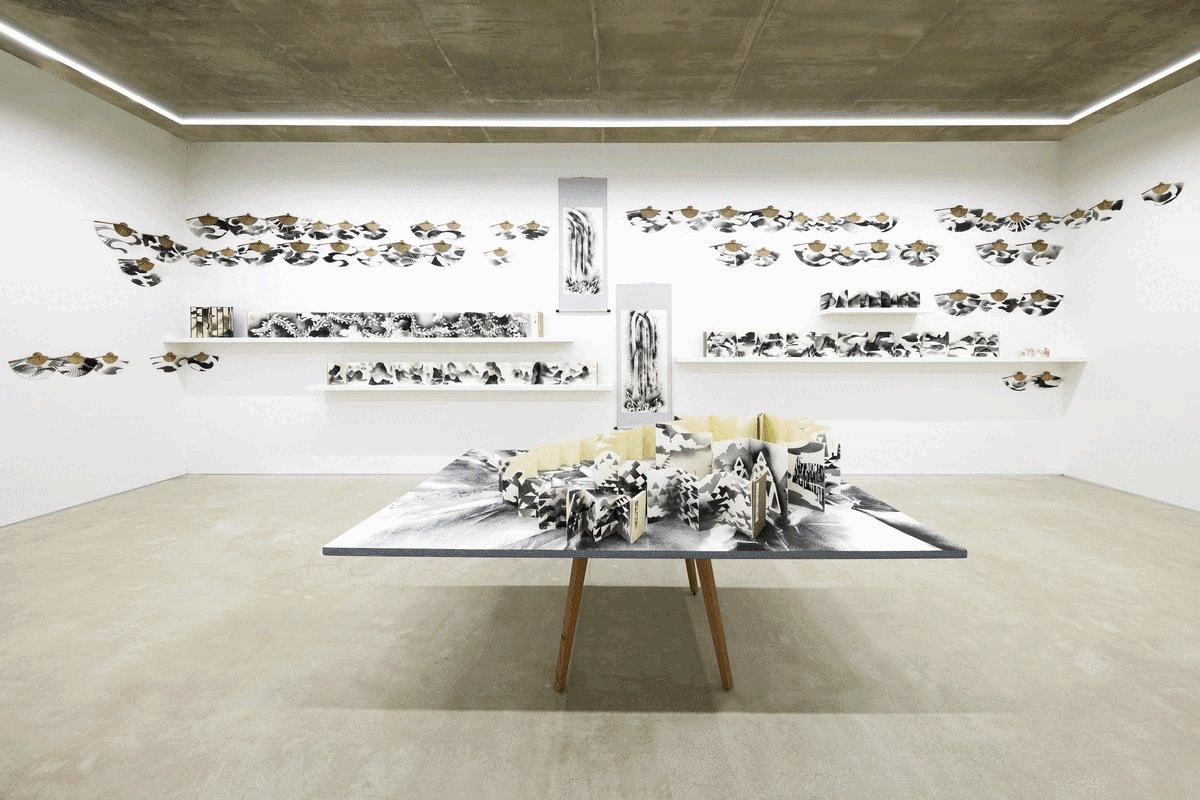 | 1, 3, 4. Exhibition views: Ink on Paper III, Gallery2, Seoul (2022). Courtesy of the artist and Gallery2, Seoul. Photos © Sangtae Kim
2: Exhibition view: Early Spring, Perigee Gallery, Seoul (2021). Courtesy of the artist and Perigee Gallery, Seoul. Photo © Sangtae Kim | |
|
Instagram Guides to Seoul |
|
We asked the artist participating in our Dui Jip Ki exhibitions to share some of their favorite places with us. Find them via our Instagram.
|
|
|
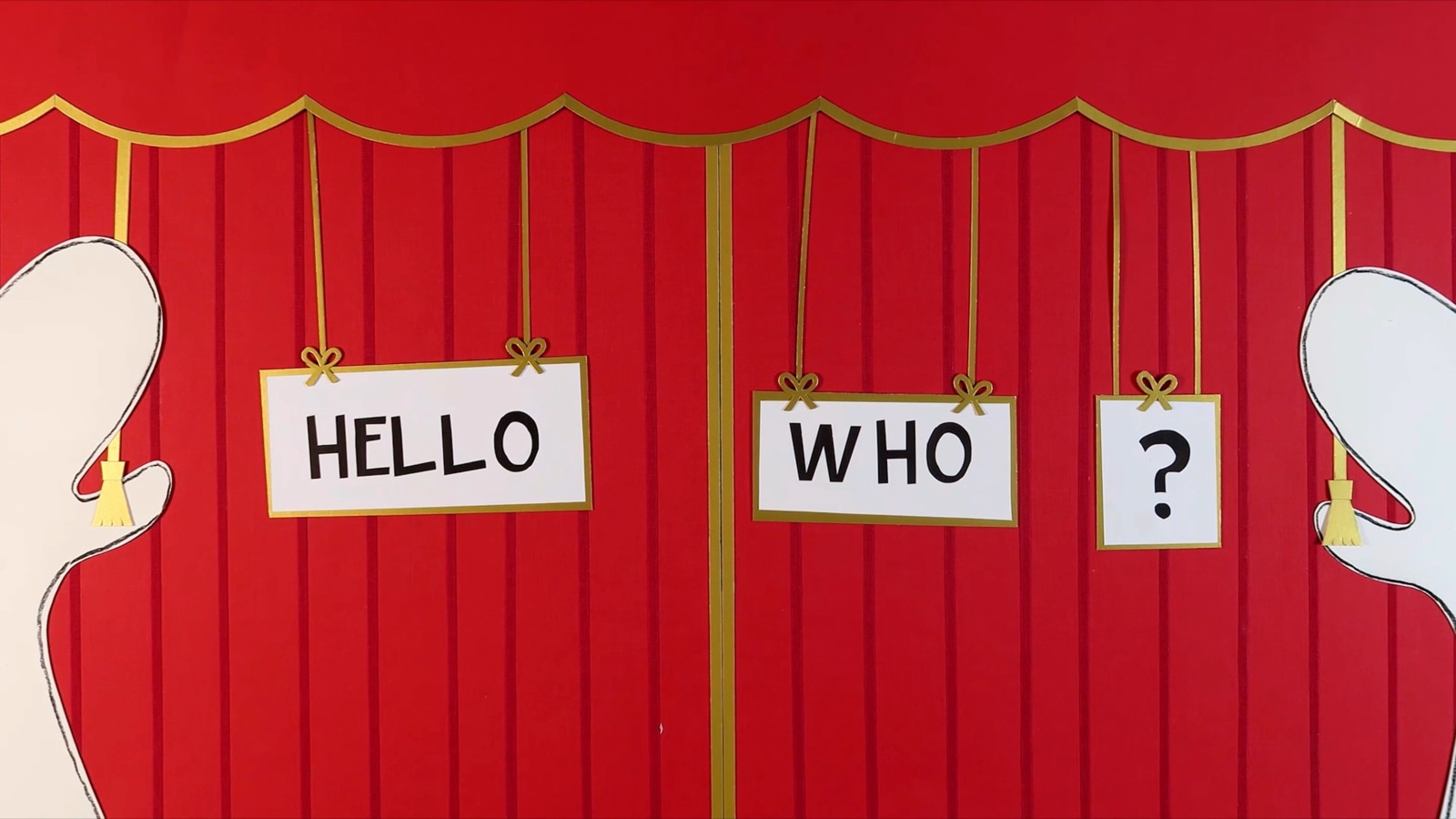 | Simon Fujiwara, Hello Who?, 2022, digital animation video, sound, duration: 02:29 min. Still © the artist
| |
|
Semi Art Community Project: Boo Gie Woo Gie Art Museum With Simon Fujiuwara
Ulsan Art Museum Through September 2, 2023 www.ulsan.go.kr
|
|
|
 | Angela Bulloch, Night Sky: Pegasus Solstice.12, 2020
LED lights, blue felt, aluminum, 201 x 268 x 7 cm. Photo © Eberle & Eisfeld | |
|
Architecture Becomes Art With Angela BullochAugust 24 – November 19, 2023 Cheongju Museum of Art www.cmoa.cheongju.go.kr
|
|
|
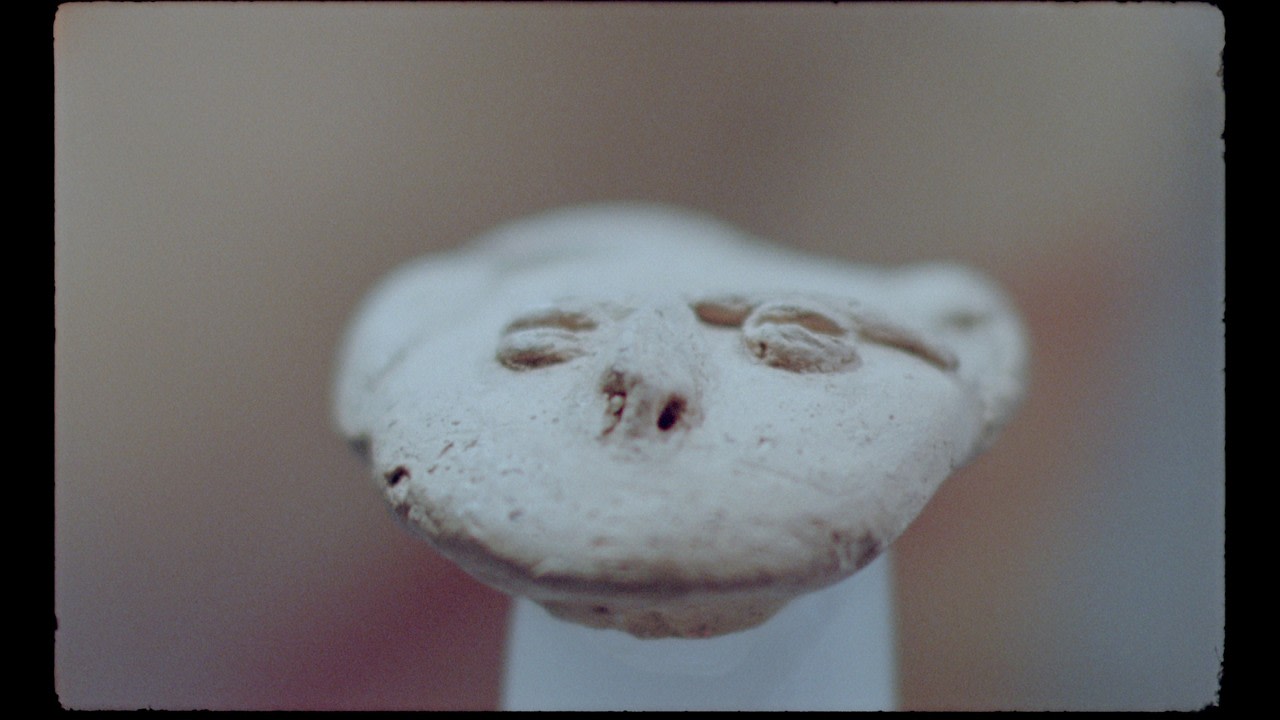 | Rosa Barba, Inside the Outset: Evoking a Space of Passage, 2021
16mm film transferred to digital and 8k film, sound, 31:15 min. Film still © Rosa Barba
| |
|
GIAF23 Gangneung International Art Festival With Rosa Barba and Tino Sehgal
Various locations, Gangneung September 26 – October 29, 2023 www.giartfestival.com
|
|
|
ESTHER SCHIPPER
POTSDAMER STRASSE 81E
10785 BERLIN
|
|
|
|
|
